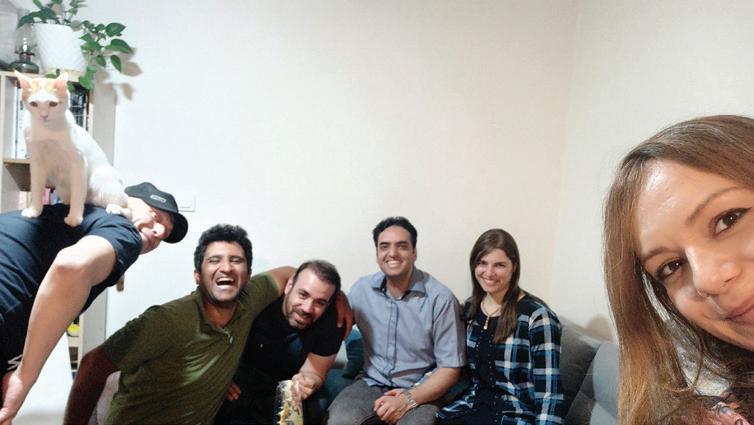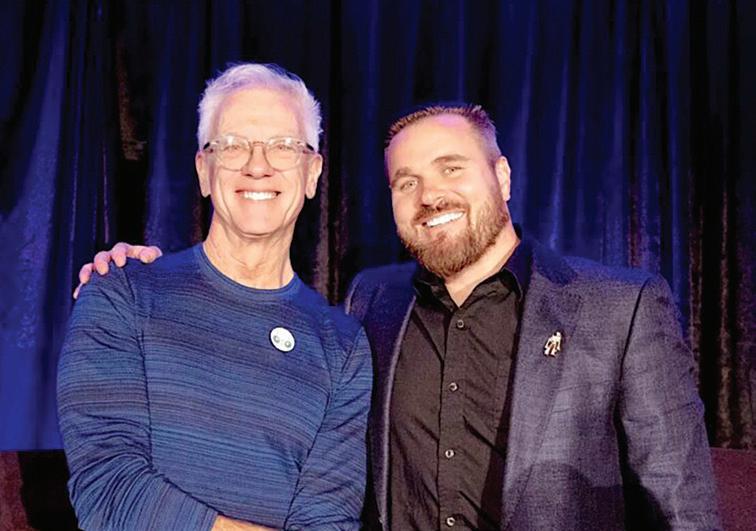








PRIME VIDEO’S INVINCIBLE S3 PIXAR’S WIN OR LOSE ADULT SWIM’S COMMON SIDE EFFECTS THE WITCHER: SIRENS OF THE DEEP



MARCH 2025
Vol. 40, Issue 3, No. 348



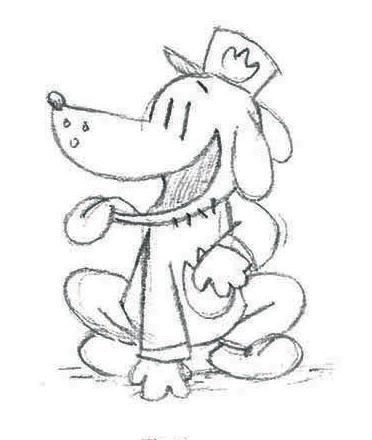
FRAME-BY-FRAME
6 March Animation Planner
8 The Must-Have List
10 Half-Man, Half-Dog, All Fun
Director Peter Hastings and his team discuss the making of the charming and high-energy new DreamWorks animated feature, Dog Man.
14 Animating Geralt
We have the scoop on the new Netflix animated feature, The Witcher: Sirens of the Deep.
18 The Biggest Night in Animation Is Back ASIFA-Hollywood president Aubry Mintz gives us a preview of this year’s Annie Awards and discusses the organization’s exciting plans for the community.
Cover A: DreamWorks unleashes Dog Man, a colorful adaptation of Dav Pilkey’s best-selling book series, in theaters this month.
Cover B: The third season of Invincible promises lots of new and exciting plot twists on Prime Video in February.
21 Your 2025 Oscar Ballot
It’s time to check out this year’s Academy Award nominations and pick your favorite animation and visual effects winners.
22 The Name of the Game
Show creators Carrie Hobson and Michael Yates offer a look at their eagerly anticipated new Pixar series, Win or Lose.
24 Fascinating Fungi
Go behind the scenes of Adult Swim’s addictive thriller-comedy Common Side Effects with co-creators Joe Bennet and Steve Hely.
28 A Big-Hearted Heroine
Emily Brunidge tells us everything we needed to know about Goldie, her new Apple TV+ show about a giant girl with a huge heart.
30 Growing Pains
The plot thickens and stakes are raised in the third season of Prime Video’s acclaimed superhero saga, Invincible.
34 Euro Visions
Find out which movies are preparing to make a big splash at the French animated feature confab, Cartoon Movie, this year.
40 Dream Houses and Magic Temples
Discover the beautiful and informative new VIZ book, Studio Ghibli: Architecture in Animation.
42 Portrait of the Artist as a Young Chimp
How the geniuses at Weta FX crafted the eye-poping visual effects of the Oscar-nominated new Robbie Williams’ biopic, Better Man.
44 Tech Reviews
Adobe’s Substance 3D Modeler, 3D Painter and Substance Sampler.
46 A First Kiss to Remember
We catch up with French director Loïc Espuche, the man behind the charming Oscar-nominated short, Yuck!
SHOT
48 Snapshots From an Animated Marriage
Oscar-nominated Iranian husband-andwife team Hossein Molayemi and Shirin Sohani (In the Shadow of the Cypress) share some of their lovely photos with us.





“








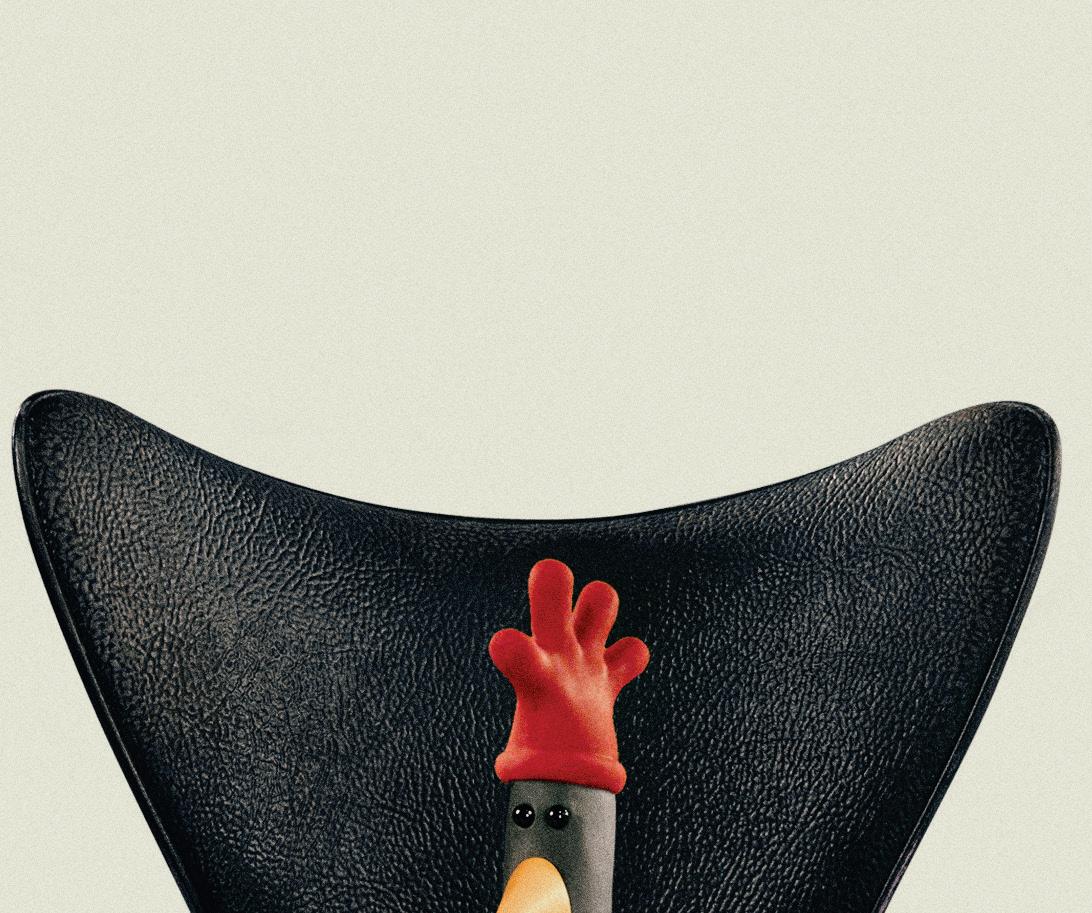
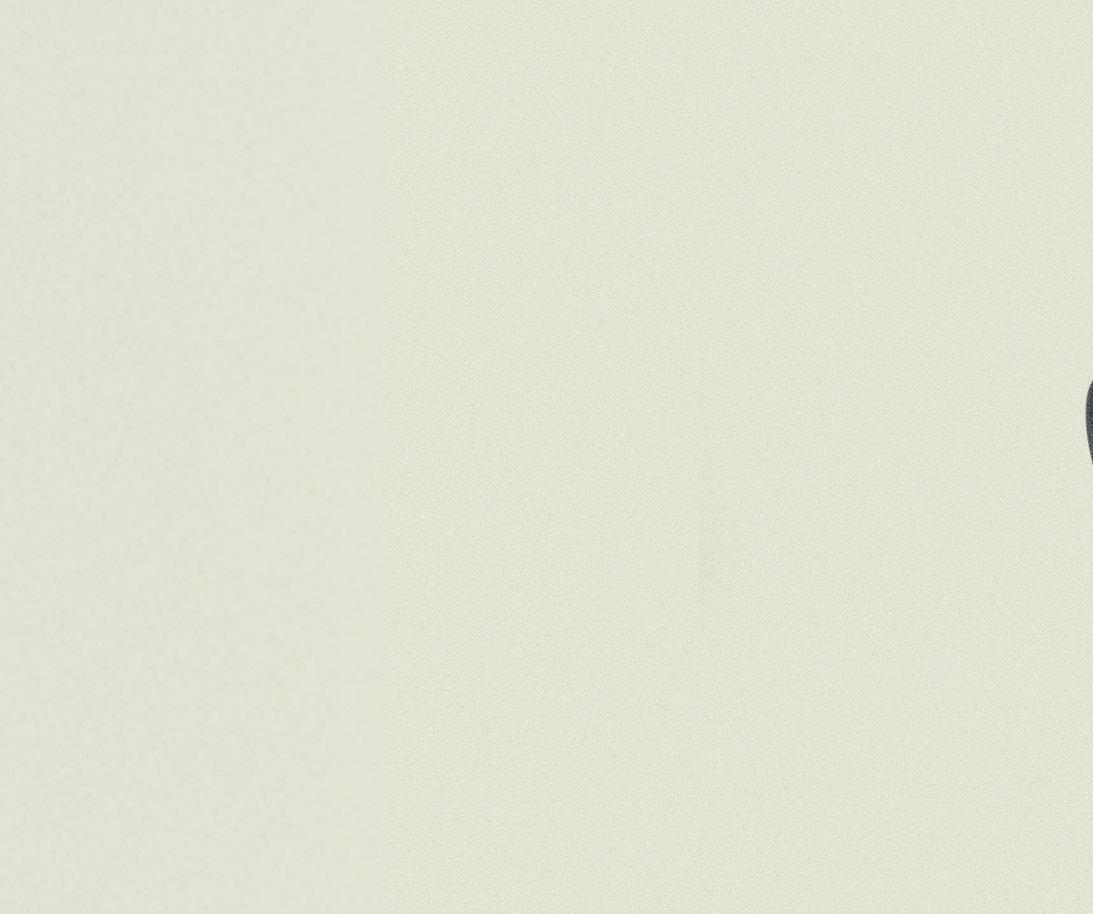














“TherE’s soMethIng speCial abOut AardMan’s clAymaTion; eacH fiLm is caRefuLly craFted anD fuLl of finGerpRintS anD impErfeCtioNs. It’s a human touch and is precisely why Aardman’s movies have remained so beloved all these years –you can feel the effort put into each one.”















As we all know, the first few weeks of the year have proved to be quite a challenging time for those of who live in Southern California. The devastating L.A. wildfires scorched a combined total of more than 37,000 acres and killed at least 28 people. Multiple neighborhoods have been leveled, leaving more than 10,000 homes and businesses in ashes. Sadly, many of our friends in the animation community were among the victims of these terrible events, and dozens lost their homes and belongings in a matter of hours.

It was heartening to witness how quickly the community came together to help those who needed help during these difficult days. Entertainment corporation such as Disney, Warner Bros. Discovery, Netflix, Amazon, Sony, Paramount and Fox were among those who pledged millions of dollars to

the American Red Cross, the L.A. Fire Department Foundation and the L.A. Regional Food Bank to help victims of the deadly Palisades and Eaton fires.” It was even more remarkable to see how quickly everyone rushed to help those in need with online community fundraisers.
We’re especially grateful to The Animation

Guild and ASIFA-Hollywood for quickly putting together helpful resource guides for the community.
A big kudos to Gravity Falls creator Alex Hirsh, who along with actors Kristen Schaal and Jason Ritter, and artists Joe Pitt and Matt Braly helped raise over $95,000 through their fantastic livestream and animation memorabilia auction.
Moving beyond the daily challenges of life in 2025, we hope you enjoy this mid-winter issue which showcases some of the wild and eclectic new animated features and streaming projects debuting this month. DreamWorks kicks off the new year with a hilarious and eye-popping adaptation of Dav Pilkey’s beloved Dog Man book series. It’s a testament to the talents of director Peter Hastings and his wonderful team that the movie manages to stay faithful to the source material, while kicking everything up a notch with its irresistible mix of fast jokes, lovable characters and huge heart.
There are plenty of other reasons to be grateful to the animation gods this month: We have an exciting new season of Prime Video’s Invincible. Netflix is premiering a new animated movie featuring The Witcher’s Geralt and some fascinating mer-people. Adult Swim is unveiling the very unusual and hugely addictive “big pharma vs. magic mushrooms” series called Common Side Effects. We also recommend Goldie, a lovely new family series from the folks at Apple TV and Mercury Filmworks from creator Emily Brundige. The fact that the show emphasizes the value of acceptance, kindness and diversity makes it even more timely these days.

Ramin Zahed Editor in Chief ramin@animationmagazine.net
“It’s also really important to me that people
see the film. [When I direct], I am making something for myself, a film that I would like to see, but I’m also interested in finding a connection with others. I also want to encourage and share my experience of working independently because I want more people to do this, so hopefully,
we’ll see more films like this in the future.”
Director Gints Zilbalodis, whose movie Flow is one of the five titles nominated for the Best Animated Feature Oscar this year.
ANIMATION MAGAZINE®
March 2025
Vol. 40, Issue 3, No. 348 info@animationmagazine.net
President & Publisher: Jean Thoren
Accounting: Jan Bayouth
EDITORIAL
Editor in Chief: Ramin Zahed
Multimedia Editor: Mercedes Milligan
Webmaster: Damaso Abrajan
Asst. Webmaster: Lucy Abrajan
Tech Reviews Editor: Todd Sheridan Perry
Copy Editor: Jason Sanchez
Contributors: Ryan Gaur, Trevor Hogg, Karen Idelson, Charles Solomon, Jeff Spry edit@animationmagazine.net
ADVERTISING SALES
Phone: 818-883-2884
Fax: 818-883-3773
Director of Advertising: Sam Selvaggio sam@animationmagazine.net
EVENTS
Director: Kim Derevlany kim@animationmagazine.net
CREATIVE
Art Director: Francis Klaess
ACCOUNTING/CIRCULATION
Circulation Director: Jan Bayouth circ@animationmagazine.net
TO SUBSCRIBE
For the U.S., the rate is $60 for 1 year or $95 for 2 years. Rates for Canada and Mexico are US$75 for 1 year or US$120 for 2 years delivered by foreign airmail. Foreign rates are US$90 for 1 year or US$145 for 2 years delivered by foreign airmail. Please allow six to eight weeks for initial delivery. Also available in a digital version for $36 for 1 year or $60 for 2 years. Changes, renewals, cancellations, questons or comments: anics@magserv.com
SUBSCRIPTION CUSTOMER SERVICE
Animation Magazine
PO Box 16225, North Hollywood, CA 91615-6625 (818) 286-3119 anics@magserv.com
ANIMATION MAGAZINE
(USPS 015-877/ISSN 1041-617X)
Published monthly except for combined issues of June/July and September/October, by Animation Magazine 24943 Kit Carson Road Calabasas, CA 91302. Periodicals postage paid at Woodland Hills Post Office CA, and additional mailing offices. Postmaster: send address changes to mailing address: Animation Magazine 26500 W. Agoura Rd. Ste. 102-651 Calabasas, CA 91302
Prior written approval must be obtained to duplicate any and all contents. The copyrights and trademarks of images featured herein are the property of their respective owners. Animation Magazine acknowledges the creators and copyright holders of the materials mentioned herein, and does not seek to infringe on those rights.



CRITICS CHOICE AWARD nominee
BEST ANIMATED FEATURE
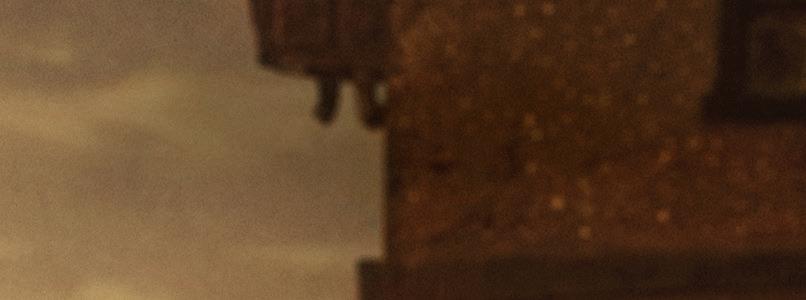
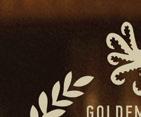
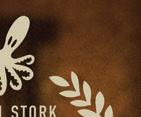
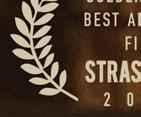








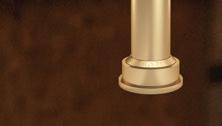
ANNIE AWARD NOMINATIONS
BEST INDEPENDENT FEATURE
BEST WRITING—FEATURE
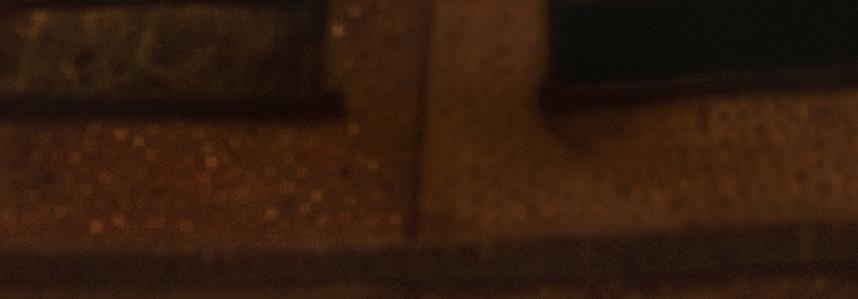



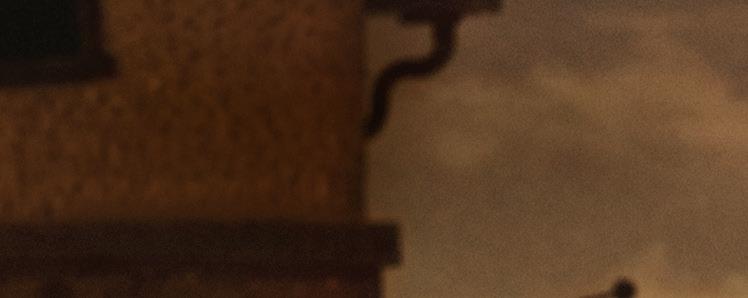
FIRSTSHOWING.NET

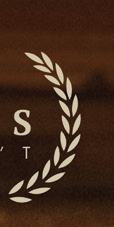




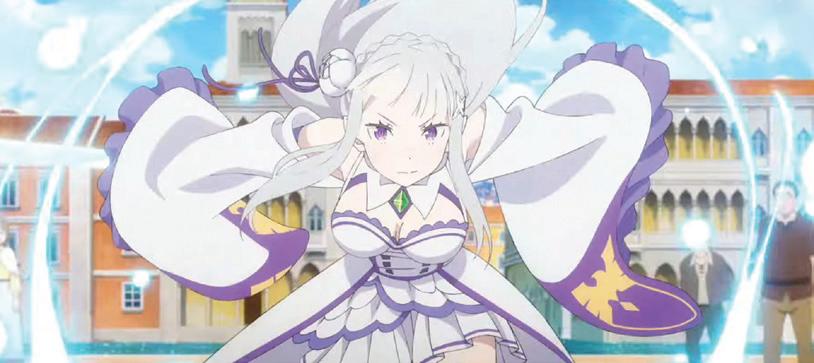

FEBRUARY
2
Adult Swim unleashes its cartoon panacea Common Side Effects
5
Get your isekai fix with new episodes of Re:ZERO S3 on Crunchyroll. 6
Invincible S3 powers up on Prime Video.
8
The 52nd Annual Annie Awards return to UCLA’s Royce Hall. 10
Attack on Titan: THE LAST ATTACK brings the towering anime terrors to theaters in the U.S. & Canada, through Crunchyroll and Sony. 11
Netflix original The Witcher: Sirens of the Deep draws Geralt into an ancient conflict with the merpeople.
To get your company’s events and products listed in this monthly calendar, please email edit@animationmagazine.net
14

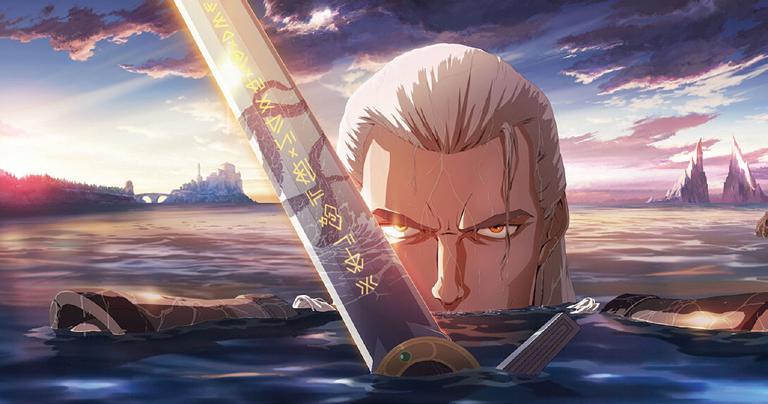
Valentine’s Day brings the adorable British bear back to U.S. theaters in Paddington in Peru!
19
Pixar’s first original series Win or Lose launches on Disney+.
28
Porky and Daffy take the limelight in The Day the Earth Blew Up: A Looney Tunes Movie, released by Ketchup Ent. GKIDS releases Mobile Suit Gundam GQuuuuuuX -Beginning-, a feature-length reedit of the TV series, across North America.
MARCH
2
It’s the big night! The 97th Academy Awards crowns the year’s animated feature and short film champions in Hollywood, airing on ABC and streaming on Hulu.
4
The next international animated sensation could be discovered at Cartoon Movie in Bordeaux, France! [cartoon-media.eu]
7
A mutant-creating meteor causes havoc in the habitats in Night of the Zoopocalypse, in theaters through Viva Kids.


Berlinale Berline, Germany berlinale.de
European Film Market Berlin, Germany efm-berlinale.de Kaboom Animation Festival Utrecht & Amsterdam, Netherlands kaboomfestival.nl Monstra Lisbon, Portugal monstrafestival.com
Tokyo Anime Award Festival
Tokyo, Japan animefestival.jp
Athens Animfest Athens, Greece athensanimfest.eu

By Mercedes Milligan
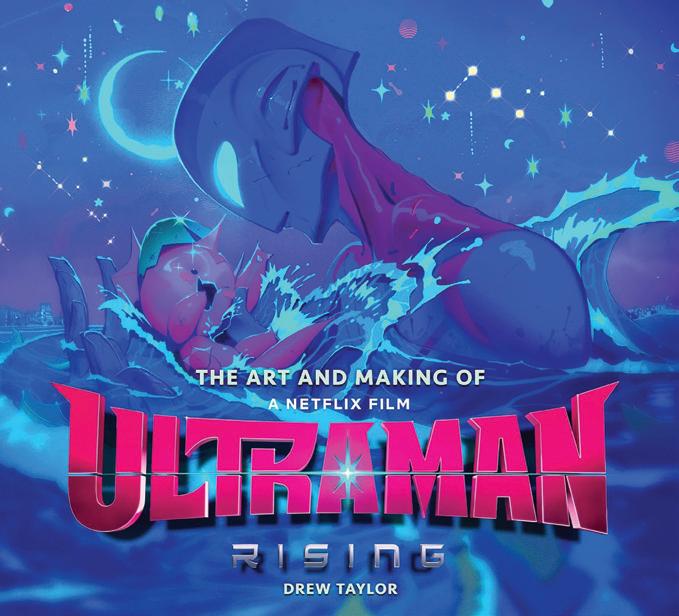


The Art and Making of Ultraman: Rising
This tome dedicated to Japan’s supersized hero, as seen in the fully-animated Netflix movie, provides artistic insight guided by author Drew Taylor. Page by page, fans can experience the story of Ultraman and his adopted baby kaiju through its design and art development evolution. The lush artwork is accompanied by commentary from the cast and crew, including writer-director Shannon Tindle and co-director John Aoshima. Titan Books / $50
The Art of Amphibia Series creator Matt Braly also teamed up with Taylor to craft this loving toad ode to his Disney toon, which follows three best friends on adventures through a magical otherworld populated by frog people and dangerous beasts. The 224-page hardcover showcases behindthe-scenes artwork, neverbefore-seen designs and dev art and insights from the crew. Voice star Brenda Song (Anne) penned the foreword. Tokyopop / $50 / March 25
Skin & Bones
Fall into the adorably macabre creative mind of Dana Terrace in her first-ever monograph, collecting artwork from the past 10 years from hundreds of personal sketchbooks. Pre-order options include sets with exclusive stickers, print, mug, shirt and even an original sketch by the artist. Best known as the creator of critically acclaimed show The Owl House, Terrace has also worked on Gravity Falls DuckTales, and has a new project titled Knights of Guinevere in the works. (Due to gory content, the book is not recommended for younger fans.)
Macross Zero LE
An exclusive deluxe presentation of the fiveepisode OVA mech series. Includes Macross Zero Zero bonus footage and audio commentary, plus a 128-page booklet, eight art cards and a poster. Crunchyroll Store / $90 / Feb. 18
Tom & Jerry: The Complete CinemaScope
Cartoon Collection
All 23 CinemaScope widescreen adventures from the iconic cat and mouse, plus three bonus Hanna-Barbera toons.
Warner Archive / $25 / Feb. 11
Felidae
The indie animation resurrectionists of Deaf Crocodile offer a very different cat tale: German director-producer Michael Schaack’s 1994 tale of grisly murder and Gothic intrigue among domestic felines. Never before released in the U.S.! Not for kids!!
Deaf Crocodile / $26 / Feb. 11



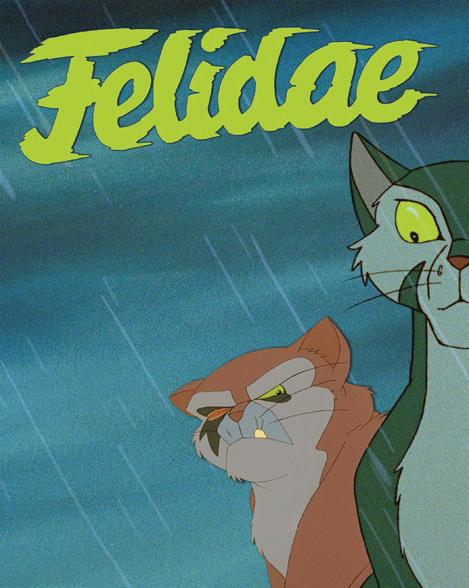


Gallery Nucleus / Tiers $35 and up / Pre-orders close Feb. 4
ICYMI, the cult hit mixed-media series Don’t Hug Me I’m Scared launched a new website at the end of 2024, creating a global hub to watch both the original webisodes and Channel 4 show. Plus, there’s an online bazaar of new merch designed by creators Becky & Joe, including apparel, accessories, prints and stickers. Celebrate the absurd with a stylish “Websites Are the Future” long sleeve shirt (£40), “Nothing” cap (£27) or the “Piñata” design tote (£25). dhmis.tv

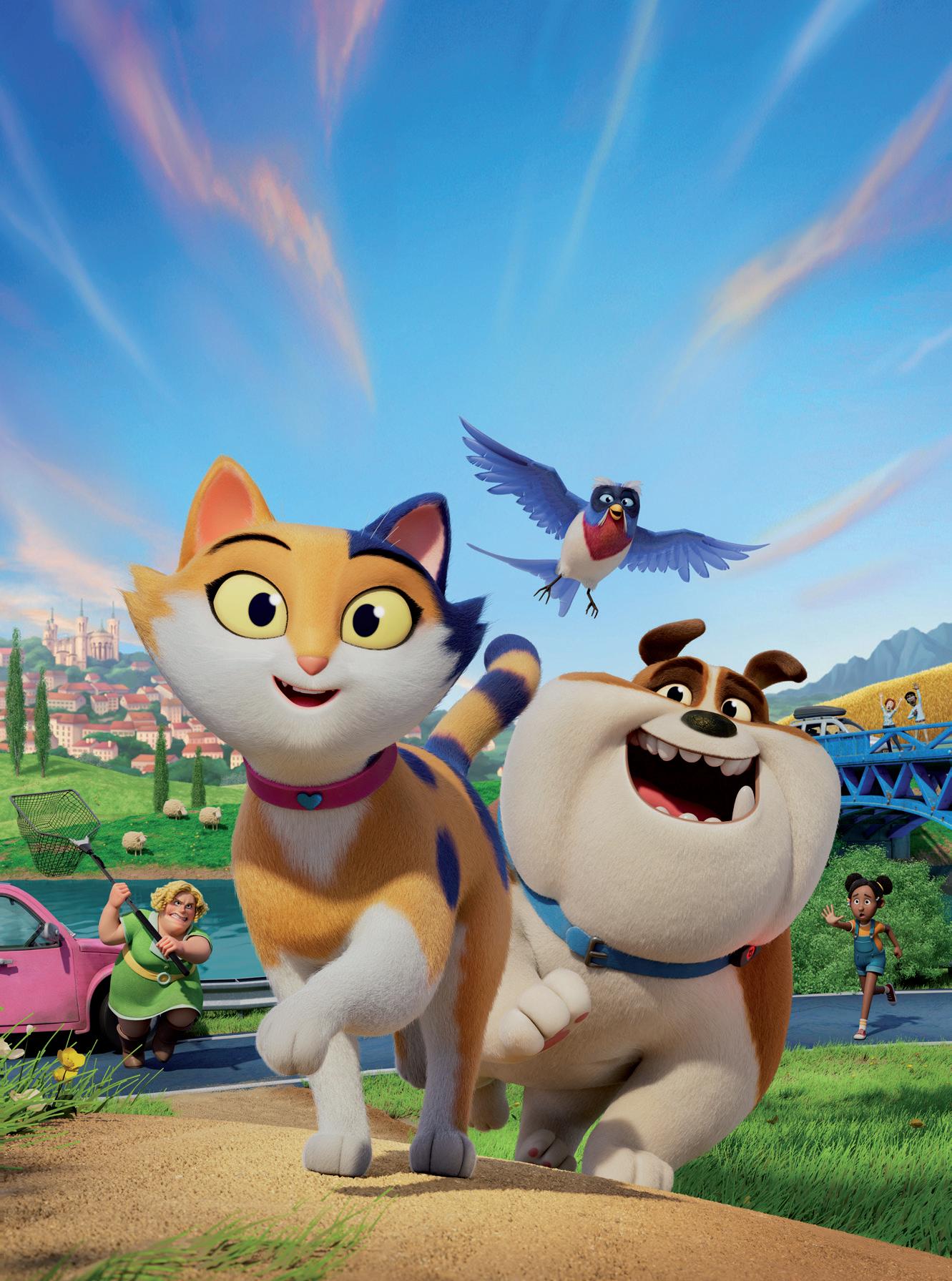



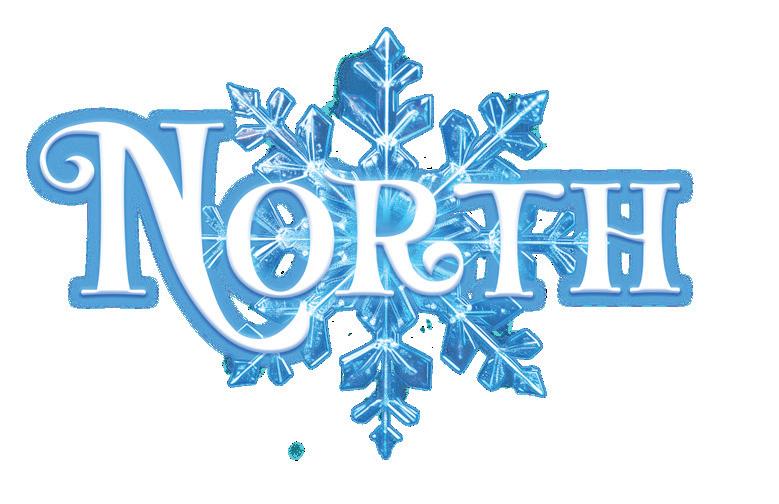



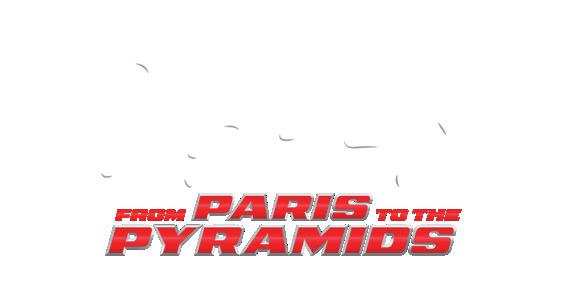

How director Peter Hastings and his team created an artisanal, handcrafted look for DreamWorks’ new feature Dog Man.
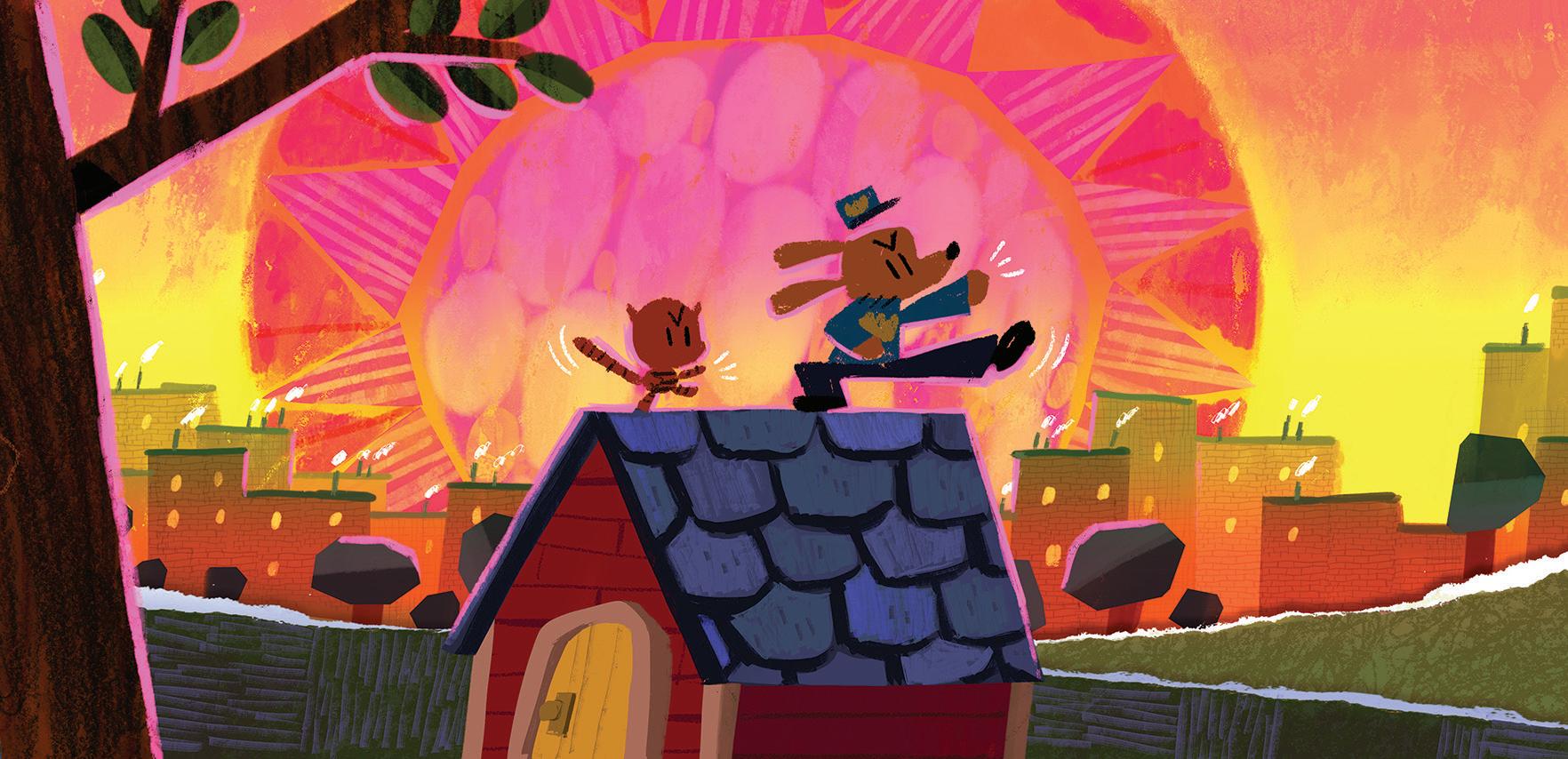
By Ramin Zahed
he new year in animation starts off on a highly paw- sitive note as DreamWorks’ eagerly anticipated adaptation of Dav Pilkey’s bestselling book Dog Man is unleashed this month on the big screen. Directed by six-time Emmy winner Peter Hastings ( Kung Fu Panda: Legends of Awesomeness, Animaniacs, Pinky and the Brain), the movie tells the story of a hybrid superhero born from a police officer and
his clever dog after a lifesaving surgery. The film features the voices of Pete Davidson, Lil Rel Howery, Isla Fisher, Stephen Root, Billy Boyd and Ricky Gervais.
“We had four major goals when we started working on the movie seriously, more than three years ago,” says Hastings, who also voices the titular character. “We wanted to make something that was intelligently silly, a film that was ridiculously cool, sophisticatedly innocent and surprisingly emotional! The keywords for the overall visual style of the movie were ‘high-end handmade.’ I am just so pleased that we
Fuzzy Frenemies: Based on Dav Pilkey’s bestselling books series, Dog Man centers on a half-man, half-dog hero who battles master villain Petey the Cat and his clone, Lil Petey.
were able to achieve all of those things and to make a movie that is smart and funny!” Dog Man’s origins go back to the first Captain Underpants book, where he was the star of an in-story comic book created by two friends, George and Harold. As Pilkey told Publishers Weekly, “By the ninth book, he was a character showing up in [their] comic. My fan mail started to change. Usually, kids would draw Captain Underpants. Starting with book No. 9, they were all drawing Dog Man. That was one of the reasons why I decided to break out and start a new series about Dog Man!”
Hastings recalls being very excited about working on this new Pilkey project, because he knew that they were on the same wavelength. “It turned out that he really loved the Captain Underpants TV series,” the director says. “Since we already had a track record of working together, he came on board. Things really started to ramp up in 2021. It took a while, but I never had any doubts that we would be moving forward with this adventure. What made this experience so much fun was that our sensibilities completely hook up.”
According to the director, one of the big challenges of the job was deciding how much of the book series’ tremendous amount of material to incorporate into the feature. “We ended up featuring storylines and characters from several of the books, including the first three volumes,” he says. “The third book, A Tale of Two Kitties, introduces some key characters (including Lil Petey, ADHD and Flippy the Fish), and the emotional life of the series really kicks up greatly there. There are also some bits from the seventh book, For Whom the Ball Rolls.”
Producer Karen Foster (Spirit Untamed) recalls that Pilkey only said yes to the project on the condition that Hastings would serve as director. “Dav originally wanted the film to be done in stop motion, but he loved what Peter had done in the TV series, so

“I am pleased that we preserved much of the look of the characters and the world from the books but were also able to expand upon it. I also love that Dog Man has these subtle messages about creativity, compassion and generosity.”
DIRECTOR PETER HASTINGS
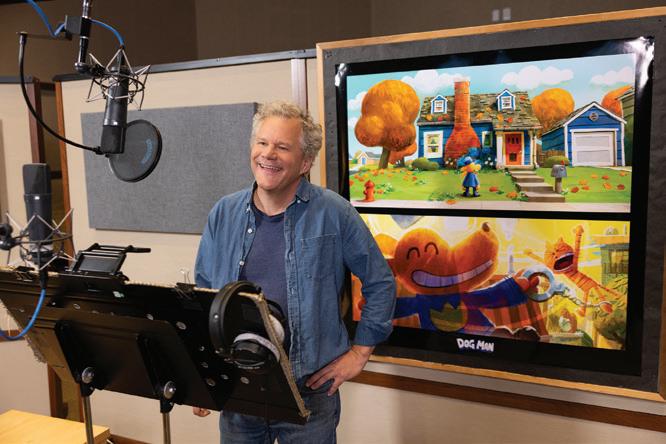
he wanted him to direct,” she says. “We all wanted our movie to have a high-end, handmade and toyetic quality — things that come to life that don’t feel like they’re completely CG-rendered. I’d describe it as a blend of CG and 2D, where things look a bit rough around the edges, as if they elevated off the page.”
As an example, she points to the simple design of Dog Man’s head. “His head is rendered in CG, but you can still see the eyes and the mouth as line drawings,” Foster says. “The approach is quite different from
anything else we have done at DreamWorks. The closest I can think of is what Blue Sky did in The Peanuts Movie … their look was quite different from ours, but the approach is similar, which was to maintain the hand of the creator, in their case Charles M. Schulz, and for us, it was Dav.”
Hastings adds, “Dav has this amazing way of telling a very silly story and dropping in some big, personal-dynamic moments. There are some emotional moments that are so true to life and don’t necessarily follow the norms of storytelling for kids. A lot of it is also because the Dog Man books are supposedly written by Captain Underpants’ George and Harold … There’s an innocence to them, so they can do and say a lot of things that would sound weird coming from an adult, but they sound perfectly normal, funny and silly from a kid. So, our goal was not to reimagine or change Dav Pilkey’s creations but to expand on it.”
The film’s award-winning production designer, Nate Wragg (Puss in Boots: The Last Wish, The Croods: A New Age), explains that his team’s visual approach took advantage of the advancements in animation technology since Captain Underpants came out over eight years ago. “Although there are certain similarities because both are set in Pilkey’s world, what’s different is that we went for that handmade, stylized approach,” he
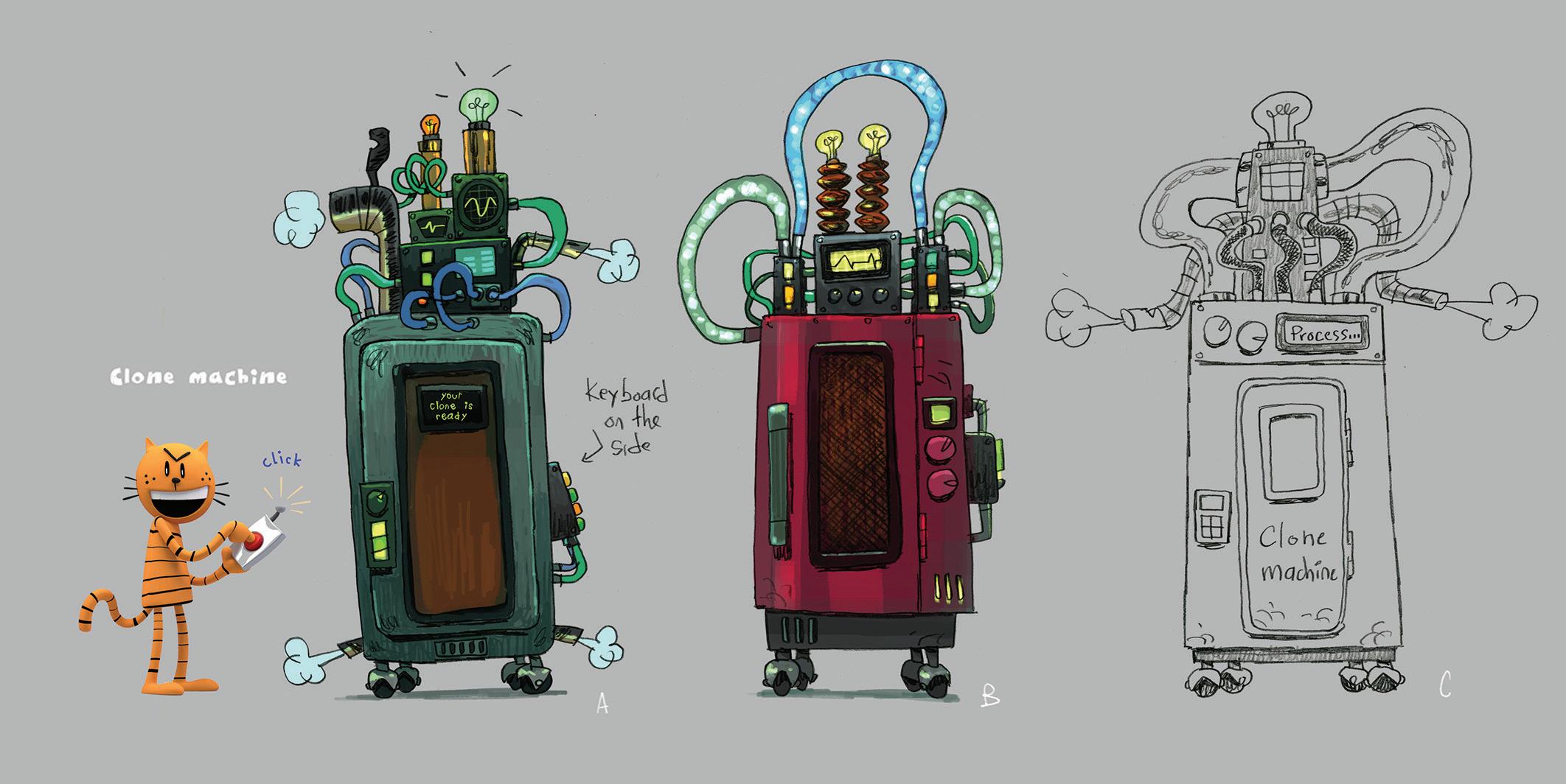

“We don’t want the audience to feel like it looks like any other CG movie they have seen … It almost feels like a collage of artistic ideas. We’re leaning into a lot of artistic and illustrated materials and stylized treatments in a CG space.”
PRODUCTION DESIGNER NATE WRAGG

explains. “We don’t want the audience to feel like it looks like any other CG movie they have seen. It almost feels like a collage of artistic ideas. We’re leaning into a lot of artistic and illustrated materials and stylized treatments in a CG space, which helped us create this jewel of a movie.”
According to Wragg, although the Dog Man world is seen through the lens of George and Harold’s imagination, it’s a living, breathing universe. “It’s made by the hands of the kids, but we’re taking the characters and their world seriously,” says Wragg. “The
boys actually make an appearance or two in it, but we don’t cut out wide and see that they’re playing with a bunch of toys. This is a totally realized world that’s highly stylized, and the characters are living in it seriously even though it’s a wildly silly world!”
Dog Man’s art director, Chris Zibach, who is also a die-hard Pilkey fan, says the wild storylines of the series allowed them to push the visual medium as far as they could. “We could be as silly and flat-out ridiculous as possible, because that’s what the books do as well,” he says. “I remember the first visuals that Nate showed us were already delivering on that promise. The shape design was already silly and ridiculous, and it had fun for fun’s sake written all over it.”


need to know that, ‘OK, these are the objects we think they are.’ So, less was definitely more here.”
Zibach says that Pilkey’s books served as the ultimate guide for understanding the amount of detail and realism to bring into their designs. “We had the ability to play in that world and try to represent something that’s both somewhat realistic but also totally follows cartoon logic. For example, when you’re depicting trees or buildings or cars, we wanted to go with the bare necessities in terms of details you


Hastings can’t wait for audiences to see the finished fruit of their labor. He says he’s been very happy with the responses to early screenings. “We screened an unfinished version of the movie, which still had lots of storyboards. They were big fans of the books and were showing up wearing Dog Man T-shirts, and they seemed to love it,” he says. “I am pleased that we preserved much of the look of the characters and the world from the books but were also able to expand upon it. I also love that Dog Man has these subtle messages about creativity, compassion and generosity. Our movie is silly, funny and a lot of fun, but I love the fact that it also sends out a very important and emotional message out into the world.”
DreamWorks’ Dog Man premiered in theaters on Jan. 31.
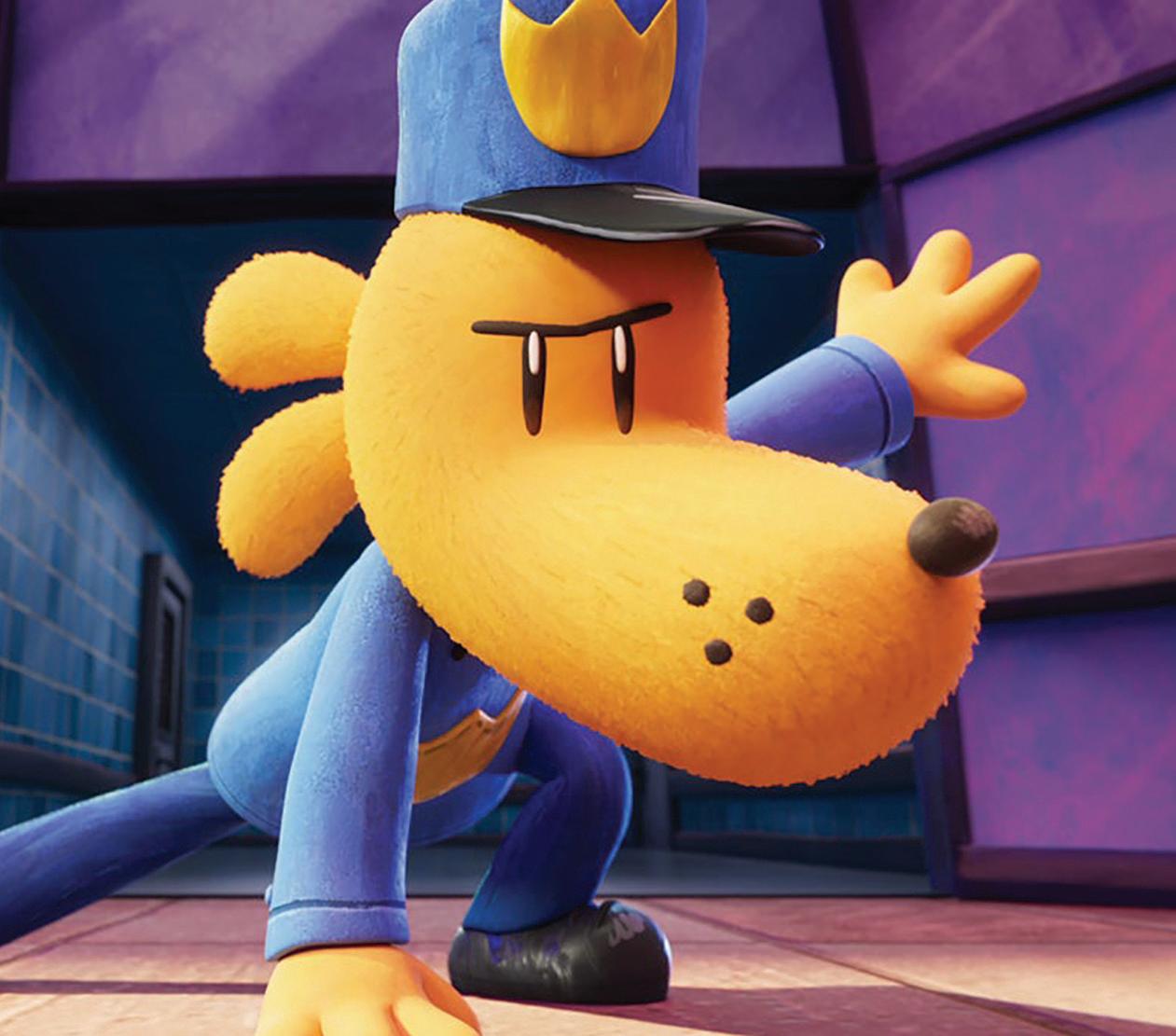
Director Kang Hei Chul offers insights into the epic new Witcher movie, which explores uncharted territories on Netflix this month.
By Ryan Gaur
he Witcher series, having received great acclaim in the literary, video game and live-action spheres, is expanding its presence in the animation world.
Following up on 2021’s Nightmare of the Wolf , a spinoff from the Netflix show, is Sirens of the Deep — a stand-alone tale based on Andrzej Sapkowski’s short story and centered on Witcher hero Geralt of Rivia.
Connective tissue between both animated
Witcher features may be limited on-screen but is plentiful in the background. For both films, Netflix enlisted the help of Studio MIR, the South Korean animation house whose recent work on Marvel’s X-Men ’97 and Star Wars: Visions has shown its capacity to deliver high-quality work with big IP. Directing the film is Kang Hei Chul, a storyboard artist on Nightmare of the Wolf who’s now in the hot seat.
“Being part of such a renowned franchise was an incredible stroke of luck and a deeply rewarding experience that I thoroughly enjoyed,” he tells Animation Magazine . “Shortly after that project
wrapped, I founded my own studio, Studio IAM, and continued to collaborate with Studio MIR. Directing a feature film had always been a lifelong dream of mine, and they thankfully gave me that opportunity in the form of Sirens of the Deep. It felt like destiny had invited me back into the world of The Witcher.”
With the universe of the games and show well established, it was key for Kang to bring a fresh perspective to Sirens of the Deep, even beyond what was present in the initial short story. “We wanted to make new


grounds purely based on the script [by Mike Ostrowski and Rae Benjamin], but we believe the overarching values of the franchise were loud and clear,” he adds. “It’s ultimately the story of connection, where our characters who once felt destined to solitude discover each other to find redemption and hope, which is deeply reflective of the reality we experience in our lives. It became our source of inspiration and where we started with this film.”
Sirens of the Deep focuses on a conflict between humans and a race of merpeople, which Kang saw as a chance to comment on real-world attitudes. “If there was one new theme I wanted to explore, it would be the idea of inviting the audience to connect emotionally with beings vastly different from humans and, through their perspective, gain a renewed understanding of humanity,” he says. “This theme becomes more pronounced through the relationship between Sh’eenaz [merpeople] and Agloval [humans], and their love, conflict and sacrifice.”
More new ground was broken simply
by depicting The Witcher ’s famous main character in a new medium. “This was actually the first time we’ve shown Geralt in animation,” Kang says. “We had to create Geralt from the ground up to adapt him to the animation world. The live-action and animated versions of Geralt are essentially the same person, but I believe each medium required a distinct approach to his depiction and emphasis. In the live-action series, Geralt’s internal struggles and his human side are the focus. He is constantly wrestling with his fate and responsibilities, often cornered to make difficult choices in complex situations. The series delves into his emotional experiences, relationships and the sense of isolation he feels within human society. His relationships with Ciri and Yennefer highlight his softer, more reliable side, allowing the audience to connect with him on a deeply human level.”
Sirens of the Deep focuses on Geralt’s identity as a legendary Witcher. “We amplified the use of fantastical and dramatic visual elements to showcase his fighting skills to capture his Witcher side,” explains the director. “The film is set in a mystical underwater world where Geralt battles powerful monsters. Naturally, we wanted the animated version of Geralt to look more
and majestic. We wanted to highlight
strategic brilliance and dynamic combat skills. Animation is an excellent medium for stylizing fantasy elements and actionpacked sequences, elevating the visuals beyond what live action could achieve.”
Because fans of the franchise are already familiar with Geralt’s appearance as depicted in the games and live-action series, the project couldn’t change it too much without risking a disconnect with the audience. “We kept the essence of

“The live-action and animated versions of Geralt are essentially the same person, but I believe each medium required a distinct approach to his depiction and emphasis.”
DIRECTOR KANG HEI CHUL

his iconic costume and hairstyle while adjusting his face and body figure for animation,” says Kang. “Our aim was to reflect his tough, aggressive personality through the character design.”
The film’s oceanside setting also required Kang to move away from The Witcher ’s typically dark mood. “We realized that the darker approach limited our ability to capture the unique atmosphere of the ocean,” he explains. “To bridge the existing franchise with the new film, we drew inspiration from various myths, ranging from Eastern European sea legends to the Greek tales of sirens. We wanted to convey the mysterious
and perilous beauty of the ocean through elements like shimmering reflections on water, the glow of bioluminescent sea creatures and vibrant, dreamlike colors set against the dark depths of the ocean.”

“Animation gave us the creative flexibility to explore richer, more dynamic compositions, and the shift to a surreal, ethereal aesthetic was key to capturing the haunting allure of the sirens and the sea,” says Kang. “This approach extended to character designs as well. The sirens were not simply depicted as beautiful beings but as enigmatic and menacing. Their appearance and movements were inspired by the anatomy of sea creatures, blended with our artists’ imagination to create something unique. Ultimately, the visual style of Sirens of the Deep was an effort to combine the weight and depth of the existing Witcher universe with the mystique of ocean legends to deliver a fresh and unique experience to audiences.”

Studio MIR’s successes with franchise projects requiring massive set pieces, often with a 2D look, are plentiful. Line producer Goun Choi explains how MIR’s pipeline is designed with this in mind, “We established a unique
pipeline by integrating our CGI subsidiary into the traditional 2D workflow. Nowadays, utilizing CG is essential, even for 2D animation titles. The role and significance of 3D animation have grown dramatically since the previous film, Nightmare of the Wolf Coordinating the 2D, 3D and compositing departments to create a highly intricate pipeline was definitely a challenge. In retrospect, our pipeline has evolved with each project we take on. I can’t even begin to imagine the level of complexity our next project will bring.”
Having worked on two films in the Witcher universe, Kang still finds himself drawn to Sapkowski’s creation. “It speaks to our increasingly polarized reality, where diverse biases and values collide, but what sets this world apart is its refusal to simplify morality into black-and-white terms. Instead, it invites us to step back and ask ourselves, ‘What choice would I make if I were in their shoes?’ We can imagine ourselves in the place of Witchers, shunned by the very people they protect despite risking their lives to hunt humanity’s enemies. To make matters worse, they are manipulated like pawns in a chess game by those in power. Yet Geralt stands resolute, bringing hope to others while navigating a world filled with corruption and villainy.” n
The Witcher: Sirens of the Deep premieres on Netflix on Feb. 11.



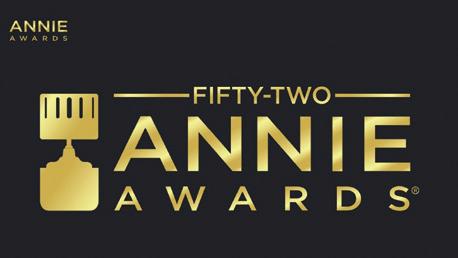
ASIFA-Hollywood exec director Aubry Mintz discusses this year’s Annie Awards and the organization’s ambitious efforts to aid and inspire the animation community.
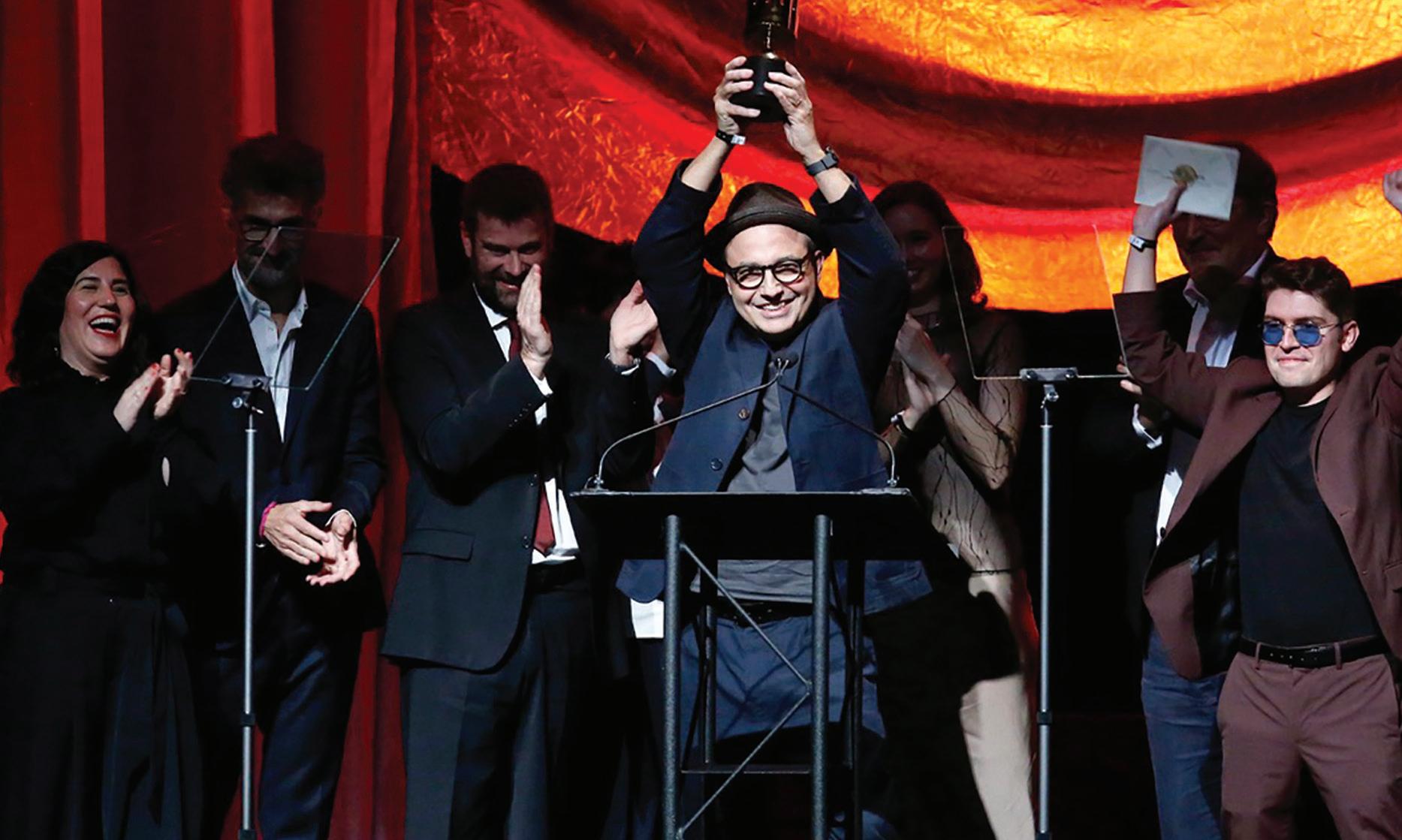
We had the chance to chat with ASIFAHollywood’s current executive director, Aubry Mintz, to find out more about what the event organizers have in store for us:
We know you’re super busy, so thanks for taking the time to give us this sneak peek. You have been active at ASIFA for many years, but this was your first year as exec director of the organization. How would you describe it?

Aubry Mintz: Amazing! I’ve been meeting tons of people at a variety of studios, conventions, festivals and schools, and learning about our art form in ways I hadn’t thought of before. I find people to be very open and giving with their time and ideas, and I love learning about
how different artists think and see the world through animation. I have been on the board of directors at ASIFA-Hollywood for almost 12 years and have learned so much from my fellow board members, and they continue to have engaging discussions that lead to policy and programs.
ASIFA-Hollywood’s former exec director, Frank Gladstone, mentored me before I stepped into this position, and I took away so many positive lessons from him on how to lead and navigate this space. Leslie Ezeh, our director of operations, is one of the most organized people I have met and keeps us all in line every step of the way, which is great for my right-side-dominated brain: It makes us a great team! The board
and the staff at ASIFA-H made this transition so very pleasant.
What do you enjoy most about the job?
The people! The community that cares so deeply about our art form. It is clear that most want animation to be taken seriously, and while that means something different to each person, at the heart of it all, I think people really love our art form and want to see it thrive. I love being a part of the conversation and being in a position to help turn ideas to actionable items with the board of directors. What are the biggest challenges in 2025? Well, currently it is the fires in California. It is horrific to watch so much of our community negatively affected. We are still learning about our colleagues who have been evacuated, and those who have lost their homes. We are pleased to report that we have just approved a fundraising initiative with an animation aid group that will have a substantial reach, and together we will work to achieve our goal of helping cover costs for those who have unfortunately lost so much. Animation is a strong, tight-knit community, and we will unite to support each other together. We also have an Animation Aid Foundation and give to animators in need when requests come by our desk, but I know we would love to do more. ASIFA-H has a goal to grow (both in staff and funding) so that we could assist more toward the needs of our community. Honestly, budgetary issues hold us back from doing all the things we’d like to do. We do make some money from the Annie Awards, but they also cost a lot of money to run. There are so many great initiatives that we’d love to take on, and although ASIFA-H has over 3,000 members, we have a very small (but amazing) staff. Ideas that are generated in our board meetings are excellent and could help a lot of people, but the challenge is how to administer them in a strategic way that

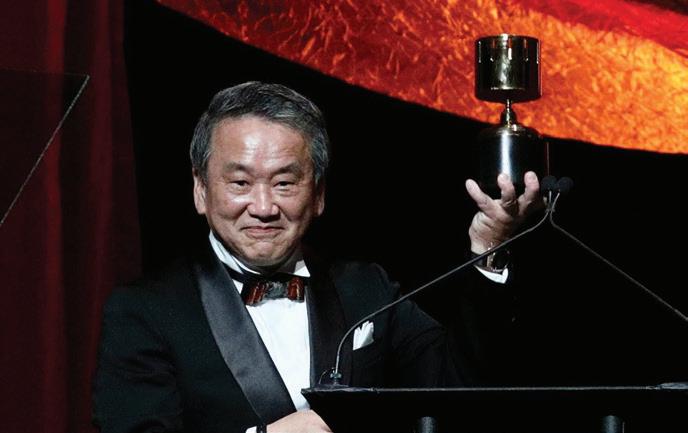


will effectively accomplish what we set out to do. Ultimately, we need more staff to do this, which means more fundraising.
A lot of people ask for more categories in the Annie Awards, and since the ceremony is already almost three hours long, we can’t conceivably add more categories, yet we know it is important to find more ways to honor artists who have gone unrecognized. With the right support, we could potentially execute big ideas (i.e., possibly a second ceremony) and really make a difference. The sky is the limit. What do you love about the Annie nominations this year?
The other awards shows often have only one or two awards dedicated toward honoring animation and VFX, but as we all know, there are so many massive teams of talent in every production that are never recognized. With 32 nomination categories, the Annies is all about celebrating the incredible achievements through the year, and this allows us to highlight the range of talent from many departments — including both commercial and independent productions. What can attendees of the awards look forward to this year?
We have a very exciting announcement that I can’t share until the night of the Annies — but I can tell you it’s something new that ASIFA-H is embarking on with an outside entity (through a generous donation) that will be of great interest to animation artists. Otherwise, expect the best glitz and glamour that animation can offer with a stellar lineup of presenters and award winners. It will be as entertaining as always and, of

course, a reunion of animation all-stars in the audience — as some people call it … the “Animation Prom”!
Are there any special plans for this year’s awards that you can share with us?
We have a very special program this year that will in part be in response to the devastation of the California fires. I am pleased to report that we have just approved a fundraising initiative that will have substantial reach into our community, and we will be announcing this at the Annie Awards! There was some talk of postponing the event, but ultimately we felt that more than ever people need to come together during this difficult time and use this opportunity to show how we can support those who have lost so much. What is your take on the state of animation in 2025?
With the union negotiations, the rounds of layoffs and the slow ramp up of production, it has been such a tough year for many. Now add the California wildfires this last week — it seems so completely devastating. All I can say is now more than ever we need to support each other and create pathways for our members to thrive. One of my goals is to spread the word about all the important opportunities ASIFA-H provides outside of the Annie Awards. We work year-round to create initiatives to celebrate, honor, support and preserve our art form and its artists. We see ASIFA-Hollywood as the heart of the animation world, and our mission is to unite the global animation community to celebrate excellence, preserve animation history, foster education and promote innovation. As the
The Winning Circle: Last year, the creative forces behind The Boy and the Heron (Best Independent Feature), Star Wars: Visions. “Screecher’s Reach” (Best TV Direction), Spider-Man: Into the Spider-Verse (Best Studio Feature) and Blue Eye Samurai (Best Animated TV Production) took home Annie Awards.
industry faces many challenges this year, it is especially important that we give our members opportunities to come together and create community. It is crucial for animation artists to know that they are not alone and that ASIFA-Hollywood is there to help any way that we can. Here are some steps we have taken to help:
If you are an animation student or faculty member, the Animation Educators Forum (AEF) has several events throughout the year for educators and students to discuss important topics, and we offer over $70,000 in scholarships and grants for students and faculty worldwide to apply to. animationeducatorsforum.org
For the animation enthusiasts — our Animation Preservation Project identifies, restores and preserves films at risk of disappearing while raising awareness about the importance of preserving our art form’s history. asifa-hollywood.org/about-us/ film-preservation
For tech-conscious artists, we support the development of open-source software that brings free licensing to our members. asifa-hollywood.org/about-us/open-source-software
And for those going through difficulties this year, our Animation Aid Foundation can provide financial assistance to help in a small way, if possible. asifa-hollywood.org/ about-us/animation-aid-foundation
And we have more initiatives we are building, along with many screenings, networking events, mixers, Q&A’s and relevant discussions at conventions and festivals — ASIFA-Hollywood invites you all to join us and be a part of the conversation. This will be a great year because of the community that surrounds us, and we look forward to growing together. n
The Annie Awards will take place on Saturday, Feb. 8 at UCLA’s Royce Hall. For more info, visit annieawards.org.
Last month, the nominees for the 52nd Annie Awards were announced in 32 categories. DreamWorks’ acclaimed feature The Wild Robot led the field with 10 nominations, followed by Pixar’s Inside Out 2 and Aardman’s Wallace & Gromit: Vengeance Most Fowl, which were lauded with seven nods each. The winners will be announced at the Annies gala on Saturday, Feb. 8 at UCLA’s Royce Hall. Here is a quick look at the major categories:
BEST FEATURE
Inside Out 2
Pixar Animation Studios
Kung Fu Panda 4
DreamWorks Animation
That Christmas
Locksmith Animation for Netflix
The Wild Robot
DreamWorks Animation
Ultraman: Rising Netflix Presents in association with Tsuburaya Prods.
Wallace & Gromit:
Vengeance Most Fowl Aardman and Netflix
BEST FEATURE: INDEPENDENT
Chicken for Linda!
Dolce Vita Films, Miyu Productions, Palosanto Films, France 3 Cinéma / distributed by GKIDS
Flow
Sacrebleu Productions, Take Five, Dream Well Studio
Kensuke’s Kingdom
Paramount Pictures
Look Back
Studio Durian / GKIDS
Mars Express
Everybody on Deck, Je Suis Bien Content / GKIDS
Memoir of a Snail
Snail’s Pace Films, Arenamedia
BEST DIRECTION: FEATURE
Chicken for Linda!
Chiara Malta, Sébastien Laudenbach
Flow Gints Zilbalodis
That Christmas
Simon Otto
The Wild Robot
Chris Sanders
Wallace & Gromit:
Vengeance Most Fowl
Nick Park, Merlin Crossingham
BEST SPECIAL
A Bear Named Wojtek
The Illuminated Film Company and Filmograf
Mog’s Christmas Lupus Films
Orion and the Dark DreamWorks Animation
Tabby McTat
Magic Light Pictures
Yuck!
Ikki Films, Iliade et Films
BEST SHORT
Beautiful Men Animal Tank, Miyu Productions, Ka-Ching Cartoons
In the Shadow of the Cypress Barfak Animation Studio
Ruthless Blade Ideomotor Culture Media Co.
The Swineherd Fleng Entertainment, Tumblehead Productions
Wander to Wonder Circe Films, Kaap Holland Film, Les Productions de Milou, Beast Animation Blink Industries, Pictanovo
BEST TV/MEDIA: PRESCHOOL
Disney Jr.’s Ariel. “Crystal Cavern Caper” Wild Canary, Disney
Gabbys Dollhouse. “Pandy’s Bad Day” DreamWorks
Jessica’s Big Little World. “Jessica’s Picnic” Cartoon Network Studios
The Tiny Chef Show. “Tiny Chef’s Spooky Stump Spectacular”
Imagine, Tiny Chef, Nickelodeon Productions
Wonder Pets: In the City. “Save Tate?” Nickelodeon/Apple
BEST TV/MEDIA: CHILDREN
Gremlins: The Wild Batch. “Never Use Double Negatives” Warner Bros.
Jurassic World: Chaos Theory. “Batten Down the Hatches” DreamWorks
Marvel’s Moon Girl and Devil Dinosaur. “The Molecular Level” Flying Bark Productions, Disney Primos. “Summer of Tater Luna” Disney
WondLa. “Ruins” Skydance/Apple
BEST TV/MATURE
Bobs Burgers. “They Slug Horses, Don’t They?” 20th TV Animation
Solar Opposites. “The What If?! Device” 20th TV Animation
South Park: The End of Obesity MTV Ent. Studios
The Great North. “Aunt Misbehavin’ Adventure” 20th TV Animation
The Second Best Hospital in the Galaxy. “The Land of Sex and Death”
Amazon MGM Studios, Titmouse Studios
BEST TV/MEDIA: LIMITED SERIES
Dream Productions. “Night to Remember” Pixar
Iwájú. “Tola” Disney
LEGO Star Wars: Rebuild the Galaxy. “Part Three” Lucasfilm Ltd.
Moon Girl’s Lab. “Moon Girl Saves the Moon” Disney
My Adventures with Superman. “Pierce the Heavens, Superman!” Warner Bros. Animation

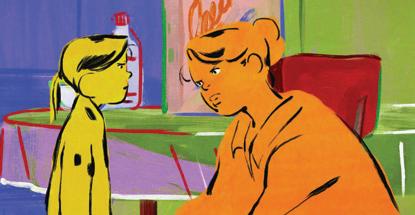




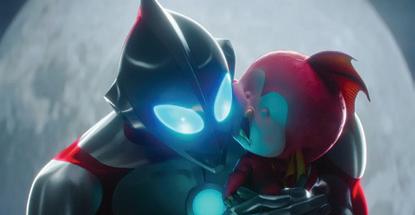
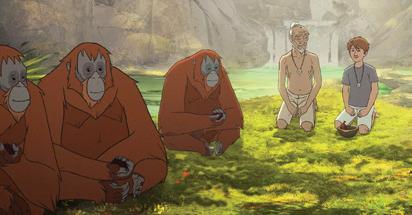
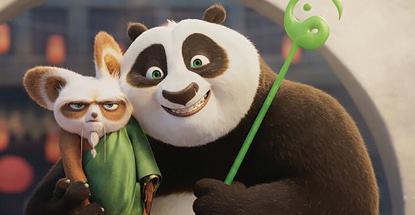



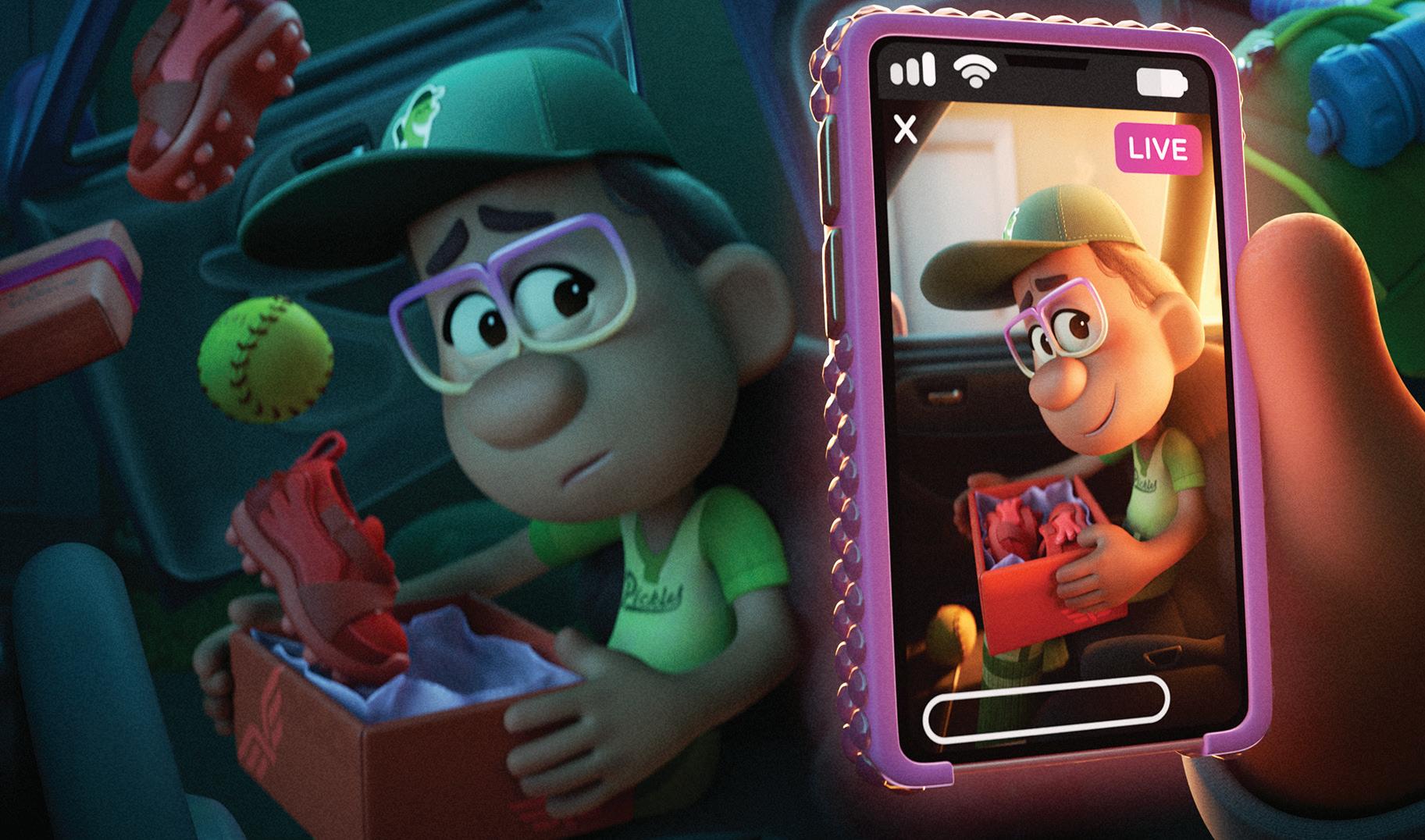
By Karen Idelson
s far as awkward experiences go, it’s hard to top middle school.
It’s a time filled with questions about who you are and what you want to do with your life. Win or Lose, Pixar’s first long-form original series from creators Carrie Hobson and Michael Yates, dives headfirst into these murky waters.
The long-anticipated show focuses on a co-ed middle school softball team named Pickles and the drama and happenings that occur in the lead-up to its important championship game. Each episode centers on a different player or parent, and the story
unfolds through that character’s point of view. Hobson and Yates are both experienced animators, though they’re both first-time directors. Hobson worked on Luca, Lightyear and Elemental, among other projects. Yates was a storyboard artist on Cars 3 and Craig of the Creek. The pair met while they were working on Toy Story 4
For them, the series’ middle school softball team serves as a metaphor for many of their feelings about work and life.
“I think, very early on, that was the guiding light for Mike [Yates] and I,” says Hobson. “It was this idea that each character is struggling
“I think we came into it knowing we wanted to tell deeper, more mature kind of character stories, and making the overall characters and worlds a little bit more cartoony gives you this kind of freedom to go darker and deeper.”
CO-CREATOR MICHAEL YATES
with something, or that they’re facing some sort of obstacle in their own personal life that feels like a loss, or, more specifically, feels like an unfair call. It seems as if they suffered an unfair judgement or a bad call in their life. It was about bouncing back from that feeling of defeat or low moment that becomes important for each character.
“That’s not just for the characters in this series,” she adds. “I find myself struggling with how you define when you’ve won, when you’ve become successful. You ask yourself what the peak accomplishment is. Sometimes, it never feels good enough, or you have a moment where a small setback can feel like a failure or a mistake made. I think the real points in life that define your character are about dealing with those moments where you make a mistake or something goes wrong, not how you deal with success.”
Once they decided that they wanted to explore the inner lives of their characters and look at their worries, anxieties and fears, the creators understood they would need
to strike a balance between these serious themes and the look of the show.
“I think we came into it knowing we wanted to tell deeper, more mature kind of character stories, and making the overall characters and worlds a little bit more cartoony gives you this kind of freedom to go darker and deeper a lot of times,” says Yates. “If you go too realistic, sometimes it feels too on the nose with the look of things, and so it helped to be more like what you expect to see in a cartoon than something that looks like what you’d see in real life. In terms of the lighting, we also we looked at a lot of theater stuff at the beginning. It felt like it was a good example of how the world can sometimes feel for individuals, as though this is a character’s moment on stage and the audience is focused on them.”

He adds, “The world of each episode revolves around a certain character, and the whole show is kind of about stepping into a character’s life and getting into other people’s shoes so the audience can feel what they’re feeling and empathize with them. It was a fun way to really push the lighting, push the production design and center around that idea that the world is a stage for all these individual stories.”
It was recently revealed that a young trans character’s storyline was deleted from the show and won’t be televised. The Hollywood Reporter published an article explaining that a character named Kai, who was voiced by transgender actress Chanel Stewart, will not express her gender identity after all. The removal has produced widespread criticism and resulted in a petition to bring back Kai’s trans-identity storyline.
In response to questions about this move, Pixar told Animation Magazine that the deletion involved several lines of dialog and that a Disney spokesperson has confirmed this change, stating, “When it comes to animated content for a younger audience, we recognize that many parents would prefer to discuss certain subjects with their children on their own terms and timeline.”
The show features a group of impressive actors in its cast. Will Forte (Saturday Night Live) voices Coach Dan, Rosa Salazar (Parenthood, American Horror Story: Murder House) is Vanessa and Milan Ray (The Wonder Years) stars as Rochelle.

The series was made almost entirely during the pandemic, with production starting in 2019 and finishing in 2023. Due to the pandemic, the creators weren’t able to do as many in-person test screenings as they would have liked, and they relied heavily on the voice talent to bring their experiences to the show.
“With the teenagers, especially, what we would try to do before every recording session [is] we would have lunch, and we would have all these questions that kind of lined up to tee off the pages as we were going to go through them,” says Yates. “We would get information from their lives about what they’re dealing with and ask them to tell us stories about situations they’ve been through. And then we would use that in the sessions to sometimes rewrite it, even in real time. We would follow what they told us about how teenagers speak, the language they use, and
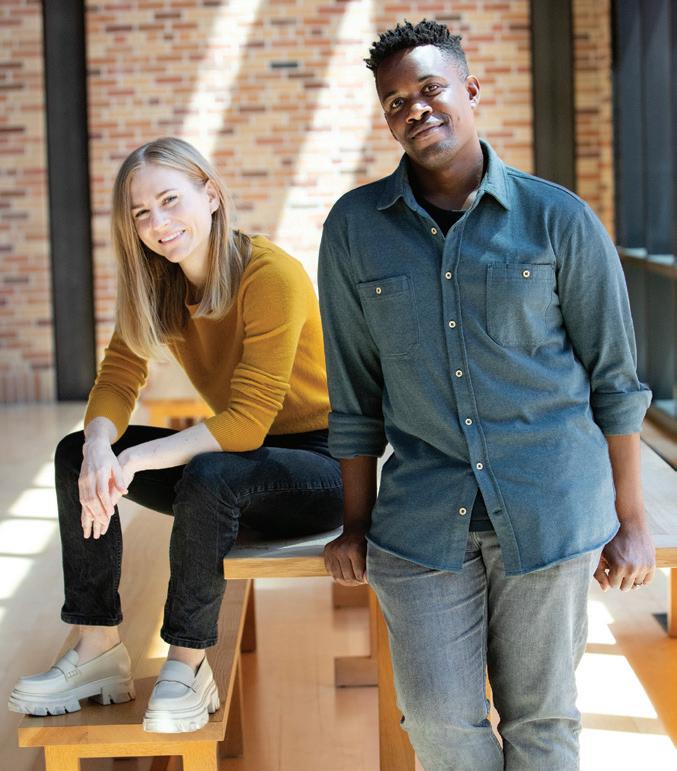
if they wouldn’t say something in the way that we’d written it, we would rewrite it so it would sound more authentic.”
Yates says that if the teens told them some lines didn’t sound right, the writers would find a way to say things that felt authentic. “If they told us a story about being bullied at school, we wanted to know how they would talk about it, how they would describe it, what they said to the person who bullied them and what the person who bullied them said,” he recalls. “It was immensely helpful for them to tell us what their experiences were and then bringing it into the stories that we told that way.”
Both Hobson and Yates loved collaborating with the voice talent as well as working with the crew on the show.
“I think it really shifts you as a person,” says Hobson of directing the series. “It’s constantly learning and relying upon others to build something with you. The best part of the job is when you get surprised by the outcome, because so much we very carefully orchestrate. As a director, I feel like the main job you’re doing is just making decisions. So, you’re basically getting all this great input of ideas to choose from, but you really must filter through it. You learn when to be decisive, and you get a sense of when to just say no to a way of doing something, versus being open-minded. And I hope that being decisive led us to make something that people will want to see.” n
Pixar’s Win or Lose premieres on Disney+ on Feb. 19.
By Ramin Zahed
f you’re looking for a timely animated show that deals with the healing powers of mushrooms and shady big pharma, Adult Swim will deliver the goods this month with the clever new comedy-drama Common Side Effects. Created by Joe Bennett (Scavengers Reign) and Steve Hely (Veep) and produced by Mike Judge (Beavis and Butt-Head, Office Space , Idiocracy ) and Greg Daniels ( King of the Hill), the half-hour comedy thriller follows the adventures of two former high
school friends, one of whom has discovered a mushroom that can heal almost anything. The series’ co-creators, who were introduced through Judge and Daniels around five years ago, recently spoke to Animation Magazine about their hilarious and highly addictive show and their inspirations.
“Steve and I realized that we both shared a common interest in mushrooms, and our sensibilities and sense of humor and favorite movies really aligned,” recalls Bennett. “As we chatted, we realized that we’re both thinking about psychedelic drugs, medicine, big pharma and conspiracies,” says Hely. “We
talked about what would happen if there were a medicine that would cure almost anything and who would be after that, and how it would really mess up the world. So, that’s how we started to build up our show.
“We’ve been working on this show for a long time now, and it went through a couple of iterations,” says Hely. “We originally sold the show to Amazon, but then they passed
Mycological Mystery: A powerful pharmaceutical company tries to hush up the discovery of a mushroom that can heal disease in Adult Swim’s addictive new show Common Side Effects


“Some of them will kill you. Some will make you feel crazy, and others are delicious. The more you learn about mushrooms, the more interesting they get!”
CO-CREATOR
STEVE HELY
on it. Joe was like, ‘I’m going to show these fools what they’re missing by animating a little bit of it,’ and once people saw what we were going for, it was an easier sell. It’s so cool to be part of Adult Swim. I watched their shows when I was a kid. They have such a cool brand, and it’s been great to work with them.”
The show’s animation is produced by Green Street Pictures, the Pasadena-based indie studio founded by Bennett, James Merrill and Sean Buckelew that also produced Scavengers Reign. “A lot of the same artists that worked on that show also contributed to Common Side Effects,” says Bennett. “We also worked with a lot of international artists from France, Portugal, Spain and Mexico. The studio was born out of the pandemic, and we were just very used to working with remote artists. It’s been a wonderful experience.”
Hely says he loves that the show is a nice blend of thriller and comedy. “It’s something that’s quite unusual and has a tone all its own,” he says. “I love the fact that it doesn’t easily fit into any particular box, and it’s been very cool to explore and gives us a lot of freedom. We’ve also come to love Marshall and Frances, [the] main characters of the show. Some of the people you meet in this show are just fun to play with.”
“I like that it’s grounded and cinematic,” says Bennett. “It feels like there are necessary reasons that it needed to be animated. It would be very difficult to do certain things in live action. I don’t think it will be defined by its medium.”
Of course, another exciting part of the job for the duo was working with Mike Judge, who provides the voice of Rick Kruger, the shady president of the big pharmaceutical company trying to get its hand on the fantastic fungi. “Mike was a big fan of Joe’s, and he really respects his work as an animator,” notes Hely. “He plays this CEO of a big pharma company who’s a little beaten down by life when we meet him. Mike is such a legend of comedy and animation, and it was just great to have him around.”
Both Hely and Bennett are pleased that the show was able to tackle some timely and important issues. “We all have these questions about what it means to be healthy

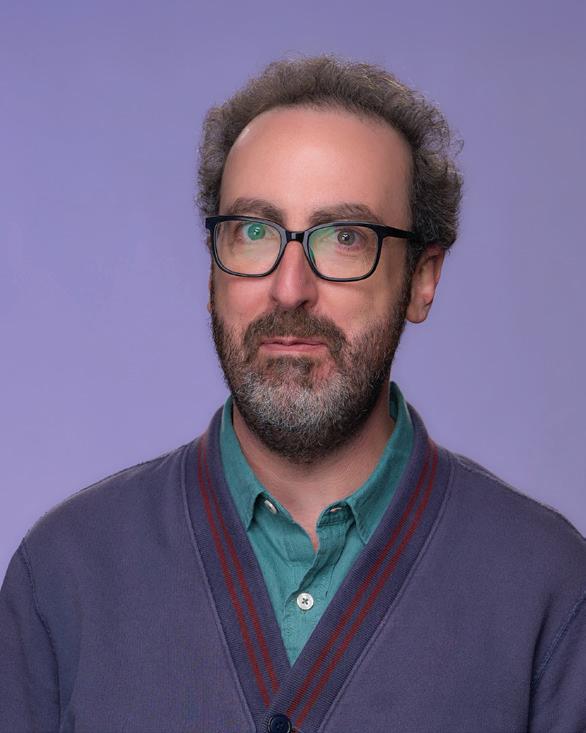

and how they constantly change things that are good or bad for us,” Bennett says. “Medicine is so complicated, and the results of traditional medicine are so weird, and there are all these treatments that can’t possibly be good for [the] body with all these
crazy chemicals being blasted into your body. The way these powerful billionaires in charge operate was also interesting to us, and the way the system corrupts people and forces us into these weird traps.
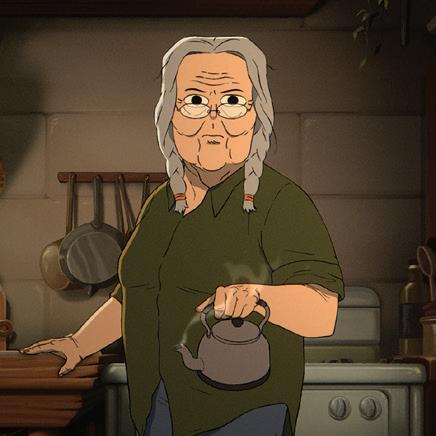

We were thinking about how people deal with healthcare and interact with pharmaceuticals both legal and illegal.” Hely mentions that both he and Bennett were fascinated by the possibilities offered by mushrooms. “We were talking about Paul Stamets [author, mycologist and entrepreneur who sells various mushroom products through his company] and questioning why alternative medicine continues to be seen as a weird taboo although we all see these incredible medicinal properties these types of things can offer.”
The show creators mention that they hold themselves to very high standards. “I’d say that this is a really ambitious project,” admits Hely. “We want it to be as good as a Coen brothers’ movie. Joe has this gift for finding incredibly talented people and getting everyone on the same page. I think this will be a project that will put Green Street Pictures on the map.”
The animation team used a wide range of 2D-animation tools including the Adobe suite, Harmony, TVPaint and Animate, because the staff worked remotely all around the world. “We should shout out all our unsung coordinators and production people who were putting material together from all these different formats, and it was amazing how smoothly they were able to do it,” says Hely.
“We really wanted to have a really cinematic look,” adds Bennett. “So you see lots of focus blurs and such. We had an amazing colorist and art designer, and our art director, Wes McClain, is really incredible. Overall, we were just trying to establish a show that visually felt like an expensive live-action show.”
Hely and Bennett hope that the show will help relieve people’s anxiety. “Hopefully, our viewers will feel excited and thrilled and will also laugh a lot” concludes Hely. “I hope they feel about these characters the same way they feel about real people. That would be great to achieve, because that’s the real trick of what we’re trying to do.” n
Common Side Effects sprouts on Adult Swim on Feb. 2.


Congrats to all the nominees for the 97th Academy Awards. Here are the animation and VFX contenders:
BEST ANIMATED FEATURES

BEST ANIMATED SHORTS


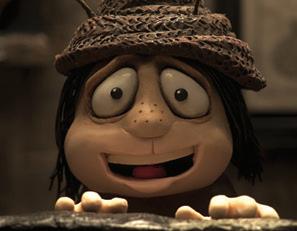


BEST ANIMATED FEATURE
Flow
Director: Gints Zilbalodis, Janus/Sideshow
Inside Out 2
Director: Kelsey Mann, Disney/Pixar
Memoir of a Snail
Director: Adam Elliot, IFC Films
Wallace & Gromit: Vengeance Most Fowl
Directors: Nick Park and Merlin Crossigham, Netflix/Aardman
The Wild Robot
Director: Chris Sanders, Universal/DreamWorks
BEST ANIMATED SHORT
Beautiful Men
Director: Nicolas Keppens
In the Shadow of the Cypress
Directors: Hossein Molayemi, Shirin Sohani
Magic Candies
Director: Daisuke Nishio
Wander to Wonder
Director: Nina Gantz
Yuck!
Director: Loïc Espuche
The 97th edition of the Academy Awards will be held on Sunday, March 2, beginning at 7 p.m. ET / 4 p.m PT at the Dolby Theatre at Hollywood & Highland Center in Hollywood, and will be televised live on the ABC Television Network. Conan O’Brien will host the ceremony. For more info, visit oscars.org.




BEST VISUAL EFFECTS
Alien: Romulus
Eric Barba, Nelson Sepulveda-Fauser, Daniel Macarin, Shane Mahan, 20th Century
Better Man
Luke Millar, David Clayton, Keith Herft, Peter Stubbs, Paramount
Dune, Part Two
Paul Lambert, Stephen James, Rhys Salcombe, Gerd Nefzer, Warner Bros.
Kingdom of the Planet of the Apes
Erik Winquist, Stephen Unterfranz, Paul Story, Rodney Burke, 20th Century
Wicked
Pablo Helman, Jonathan Fawkner, David Shirk, Paul Corbould, Universal
ANIMATION IN OTHER CATEGORIES
Flow
Best International Feature
The Wild Robot
Best Music: Kris Bowers
The Wild Robot
Best Sound: Randy Thom, Brian Chumney, Jeff Levy, Bob Gremore
Porcelain War
Best Documentary Feature
Emily Brundige, the creator of Apple TV+’s new show Goldie, talks about her giant-sized character and her lovingly crafted adventures.
By Ramin Zahed
Agiant girl with a big heart is ready to stomp her way into viewers’ hearts in in Goldie, a charming new show premiering on Apple TV+ this month. Created by Emily Brundige (Hilda), who also serves as exec producer along with Emmy-winner Clint Eland, the 13-episode first season of the show follows the adventures of a giant girl who goes on some epic adventures with her best friends

she tells Animation Magazine in an email interview. “This may sound unbelievable, but honestly, the development process was a breeze thanks to my fantastic executives at Apple TV+. The toughest part was just waiting for production to begin. I think having my short film as a proof of concept from the start really helped. From the moment I pitched it, the executives were able to visualize everything — from the visual language to the comedic tone. The show has stayed true to those elements from the short.”

in their town of Boysenberg. Along the way, they celebrate their differences and learn that there’s space for everyone in this big world.
The 2D-animated family series features a stellar voice cast that includes Jessica McKenna, Dee Bradley Baker, Amari McCoy and more, along with guest stars such as Henry Winkler, Al Yankovic, Nicole Byer and Maria Bamford.
Goldie is based on a 2018 short by Brundige, an animation veteran who has written for shows as diverse as Star vs. the Forces of Evil, Teen Titans Go!, Unikitty!, Big Nate and Hilda. “In the social and political climate of 2016, I felt a strong urge to create a largerthan-life character like Goldie — a giant girl who takes up space!,”
While the writing, voice acting, songwriting and score was done in the U.S., everything else from the designs and storyboards to animatic editing was done at Mercury Filmworks in Ottawa, Canada. “The animation was done at their partner studio, Lighthouse Studios in Kilkenny, Ireland,” says Brundige. “Both Mercury and Lighthouse did an outstanding job and were amazing to work with. The
Size Doesn’t Matter: Emily Brundige’s new animated series Goldie premieres on Apple TV+ this month. The animation is produced by Mercury Filmworks and Lighthouse Studios.


“Goldie is a female character who is flawed and makes mistakes, and I want kids, especially young girls who are often conditioned by society to be perfect, to see that it’s okay to be imperfect.”
animation pipeline and overall production were led by my incredible director at Mercury, Graham MacDonald, who also served as the animation director on Kid Cosmic and the Mickey Mouse shorts.”
“I can’t say enough good things about Graham — he was a dream partner in making this show,” says Brundige. “The animation was done in Harmony, blending character rigging with drawn animation seamlessly. Paul Madden, who was also the assistant director on The Cuphead Show!, served as the director of animation at Lighthouse.”
Brundige says the art director of the original Goldie short, Germán Orozco, took her directive to create a whimsical European town, which was reminiscent of Pippi Longstocking’s home, and added his own inspiration from mid-century illustrators like Mary Blair and Josef Palacek to create a look that felt both fresh and appealing. “My genius art director on Goldie the show, Ross Love, was able to honor the unique look Germán created, while elevating it to the larger, well-rounded town of Boysenberg you see today,” she explains. “Cheyenne Curtis created the initial designs for the short. She’s a fantastic artist with a natural sense of appeal. However, when the show entered development, we wanted to make the designs feel even more unique compared to character designs we’d seen before. For example, adjusting Goldie’s eyes from a more cartoony style to something slightly more realistic helped give the character a distinct look.”
Goldie feels and looks unique, and Brundige loves that about her show. “I’ve always wanted to do a show with my special brand of humor in it, which is a kind that doesn’t hit you over the head, but sneaks up on you,” she points out. “It’s deceptively simple, and I feel like I’ve achieved that in Goldie. I also love that the show celebrates the things that matter to me: diversity, acceptance and emotional honesty. Boysenberg feels like a town we’d all want to live in. It has a strong sense of community, with everyone coming together when times get tough — even someone as grumpy as Mrs. Petunia, the little old lady and antique-store owner!”
When asked about her animation idols and influences, Brundige mentions early Peanuts specials and Pippi Longstocking. “She’s my one constant idol and forever hero,” says Brundige. “Early influences that shaped my overall creative vibe include Pee-wee’s Playhouse, early Wes Anderson films, the books of J.D. Salinger, Steven Weissman’s Yikes! comics, and Thurop Van Orman’s Flapjack series on Cartoon Network.”
According to Brundige, Goldie had one of the smoothest production of any show she has ever worked on. “I think that’s due to several factors,” she explains. “The supportive style of my Apple executives, the enthusiasm and thoughtfulness toward the show at both Mercury
and Lighthouse, my strength as a leader with a clear vision, and the talents of my head writer, Ben Greene, as well as all the other writers, actors, musicians and artists involved in the show. It was a dream project for me!”
Now that Goldie is ready for her big debut on Apple TV+, Brundige hopes the show will encourage kids to be more accepting of themselves. “Goldie is a female character who is flawed and makes mistakes, and I want kids, especially young girls who are often conditioned by society to be perfect, to see that it’s okay to be imperfect,” says Brundige. “Goldie also experiences big emotions. I want boys, too, to see a character who expresses her emotions intensely and to understand that even when she’s a giant crybaby,’ her friends still love and accept her.”
Sharing some helpful advice for animation newbies, Brundige says it’s important to know that you have everything to gain from the people you work with. “Pick your battles, stay open, and focus on keeping ideas flowing rather than shutting them down,” she offers.
“Be respectful, do your research before meeting with someone, and always maintain professionalism! n
Goldie premieres on Apple TV+ on Feb. 14.

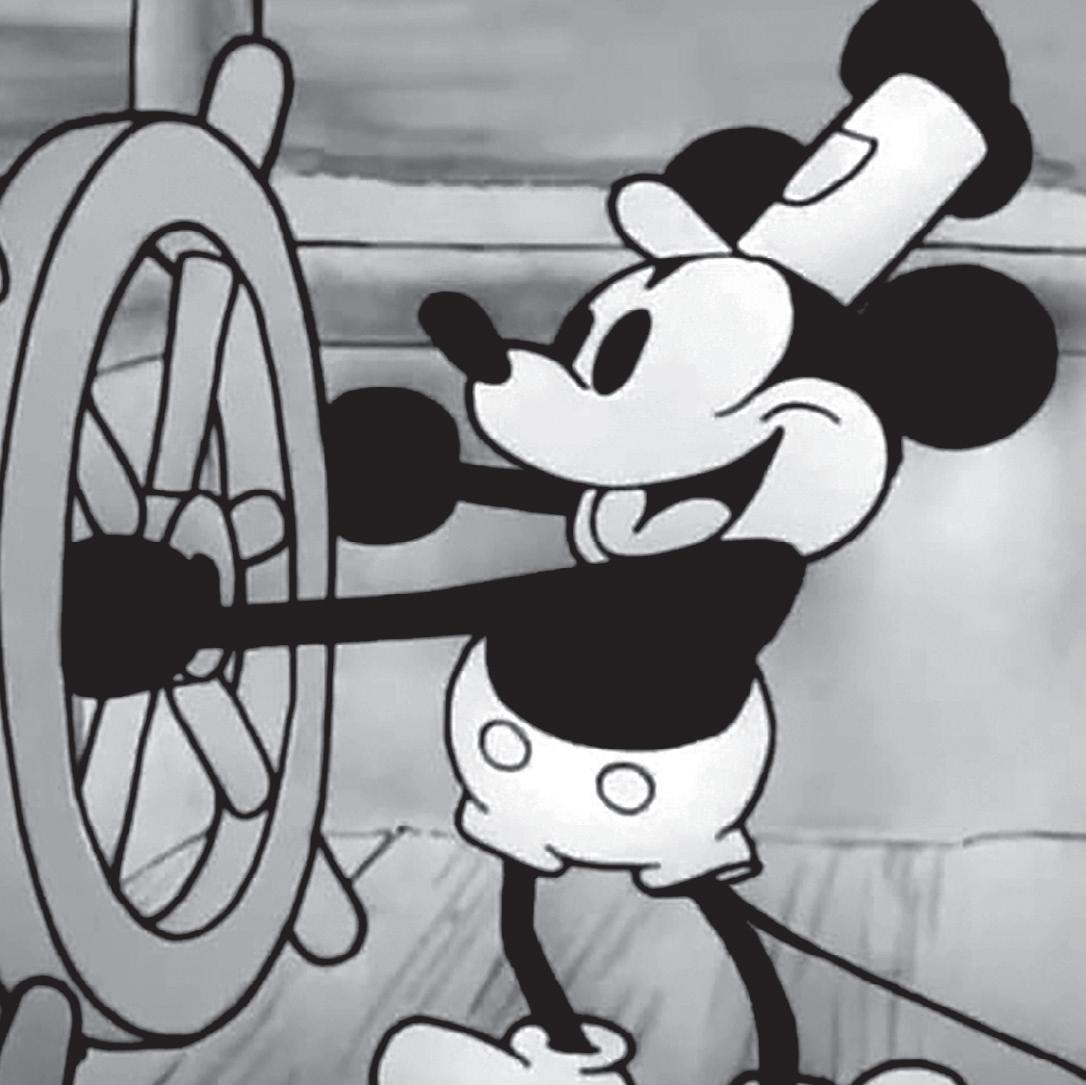
Bigger, Wilder, Crazier: The third season of Invincible introduces Mark’s transformative blue suit era in the storyline and features bigger, wilder and more intense narratives that echo what was set up in the first season of the show.




The central figures in Prime Video’s acclaimed superhero saga Invincible face more complications and confrontations in Season Three. By Jeff Spry
Prime Video’s superhero saga, Invincible, is soaring into its third eight-episode season this month with the compelling story of teenager Mark Grayson (Steven Yeun) and his violent escapades as a caped crimefighter saddled with the dark legacy of Omni-Man, his extraterrestrial father (J.K. Simmons).
Created by The Walking Dead’s Robert Kirkman and crafted from the acclaimed 2003-2018 Image comic-book series by Kirkman and artists Cory Walker and Ryan Ottley, Skybound Entertainment and Amazon MGM Studios’ Invincible series has attracted a fierce following over its last two seasons of adult-aimed animated brutality on Prime Video and received Emmy, Annie Award, Saturn and Critics Choice nominations along the way.
This fresh season promises more emotional confrontations with a guilt-stricken Omni-Man and Allen the Alien (Seth Rogen) teaming up to bust out of a Viltrumite prison, Mark amping up his training regime with Cecil (Walton Goggins) to don the notorious blue-and-black costume, the Guardians of the Globe dealing with conflicts internal and external, and Mark’s superpowered half-brother Oliver growing at an accelerated rate as Mark strives to shelter his loved ones.
“I think the center of the show is really Mark Grayson’s evolution and Invincible growing as a superhero and learning things as a superhero and making mistakes,” Kirkman tells Animation Magazine. “So we saw a lot of that in season two. He’s definitely maturing. He’s doing a lot of training, he’s doing a lot of preparing. He knows from Anissa’s visit that there’s more conflict brewing and bigger threats looming on the horizon that he needs to prepare for. That propulsion is something that’s really important to us. We’re always moving forward and throwing as many problems as possible at Mark and the other characters. Season Three is where we’re really stepping on the gas. It kicks off and hits the ground running. If you thought Season Two was fast paced, you haven’t seen anything yet.”
Executive producer and showrunner Simon Racioppa believes that part of Invincible’s promise and appeal derive from the fact that the writers never forget what has happened before.
“There’s going to be repercussions of things that happened in Season One that are going to affect our characters in Season Three,” Racioppa adds. “Nothing ever resets. A lot of our characters are carrying emotional
trauma from things that happened back in Season One. It’s really important to be true to that all the way through the run of the show. It’s never like, ‘Oh, it’s time for another adventure on Invincible.’ You could probably just start with Episode One and watch the whole series all the way through and it almost doesn’t feel like there’s any gap between the seasons. Season Three will pick up right off the end of Season Two. And we hope that helps ground the series. Terrible things happened in Season Two and that’s going to have an effect on Season Three.”
One of the most popular staples in the pop culture universe is the anxiety-ridden waiting period to see what uncanny powers blossom from the offspring of superheroes, as in the case of Franklin Richards of Marvel’s Fantastic Four world, or even baby Jack-Jack in Pixar’s Incredibles films. Such is the case with Mark’s younger sibling Oliver, the purple-skinned product of Omni-Man and his insectoid Thraxan wife, Andressa. Season Three will see Oliver emerge as Kid Omni-Man!
“We did figure out in the comics a cool narrative way to have Oliver age rapidly,” Kirkman explains. “So that even though the comic kind of plays with time at a deliberate

‘We’re always moving forward and throwing as many problems as possible at Mark and the other characters. Season three is where we’re really stepping on the gas. It kicks off and hits the ground running. If you thought season two was fast paced, you haven’t seen anything yet.’
CREATOR/EXEC PRODUCER
ROBERT KIRKMAN
pace and you don’t really have people aging in real time, you can have that character growth from a baby to wherever we get with him, which is kind of fun. Oliver represents a lot of things in the show. It’s Nolan’s influence
from afar coming into Earth, affecting Mark in some huge ways, affecting Debbie in huge ways. He’s a baby at the end of Season Two, but as you watch Season Three you’ll see he’s growing rapidly and becoming a full-fledged character that’s an integral member of our cast and shaking everything up in a lot of really cool ways.”
Kirkman feels that shifting into season three the team has clearly established what this show is.
“This is the Mark Grayson show,” he says. “But as we continue to adapt the comic there’s a lot more Omni-Man, which is really cool. It’s great to be working more with J.K. Simmons and having that character more present. Now we’re just getting into the details of the story and the characters and fleshing them out as much as possible and giving them interesting things to do, and getting to some really cool things from the comics that I think people are going to be excited to see.”
Fortified with 16 hours of the show now under its belt, Invincible can confidently stride into this next block of episodes knowing that the audience has a familiarity with its character roster.

“It lets us go deeper into relationships, spend more time with those characters, and makes it more fun to write for, too,” says Racioppa. “It’s nice having that sort of history that lets you reference that back into the characters and show what they’ve already been through affects what they’re going to do next, and their emotional state. The whole team came together in the transition. When you hit those moments it’s a beautiful high. You’re trying to achieve something great that has an emotional resonance that hopefully will affect our audience.”
As fans of the comic-book series know, Mark Grayson gets a brand new blue costume at this point in the unfolding story and as seen in the teaser trailers it makes a bold statement.
“There were a lot of variations done by the design team, Shaun O’Neil and Dou Hong and her team, trying to figure out how to interpret the blue costume from the comics,” Kirkman notes. “The costume change is a superhero trope. Spider-Man gets the black costume and everybody hates the black costume. Then two years later they get rid
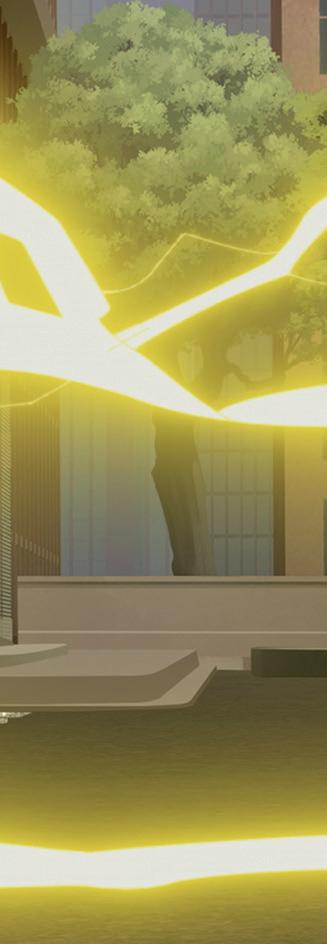
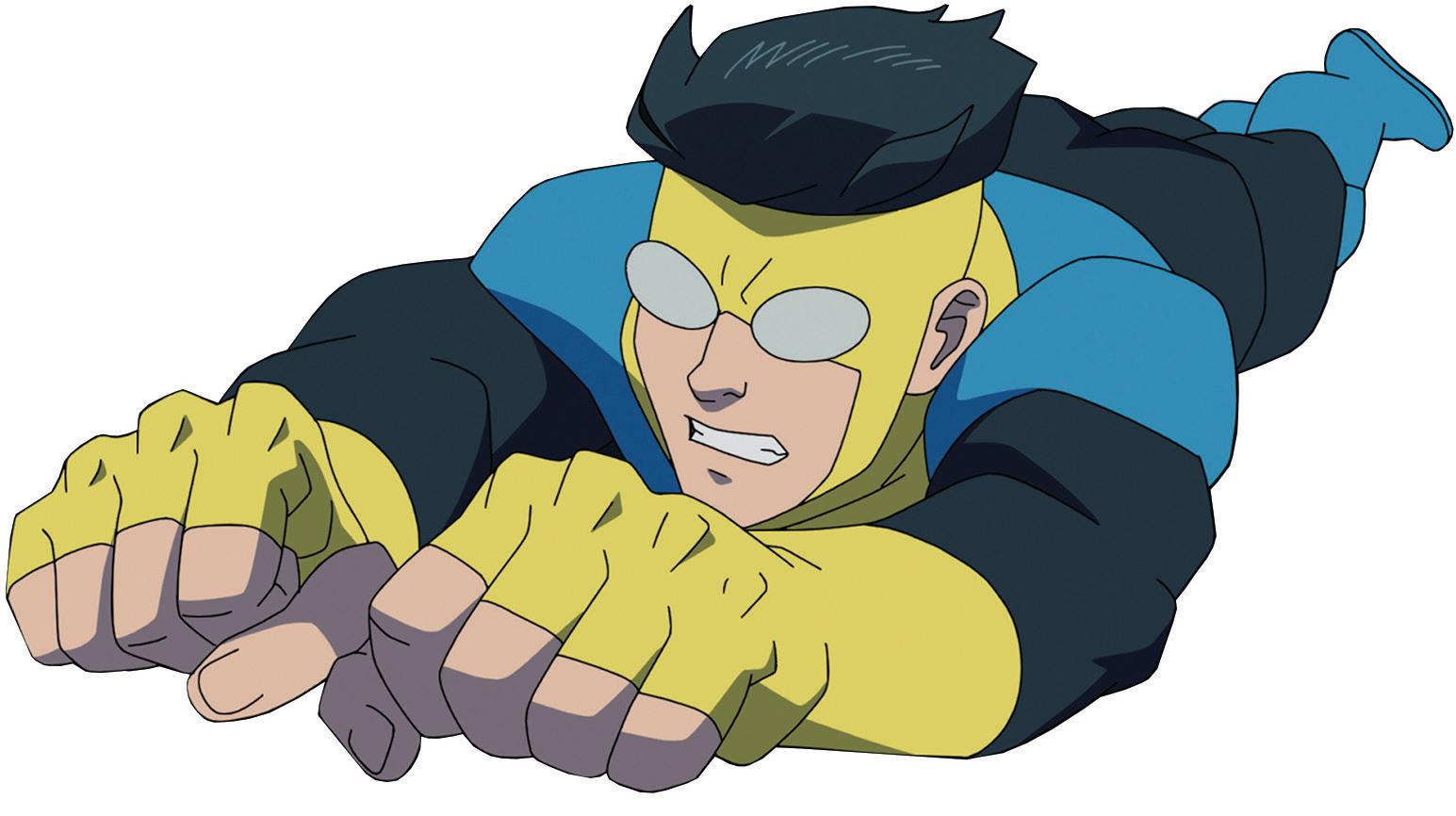
of the black costume and everybody doesn’t want to go back to the old costume. And that kind of thing actually happened. There were letters from people who didn’t like the blue-and-black costume. When we retired it and went back to the original costume there were lots of people complaining. Now that we’re doing it in the show, the fanbase that read the comics and knows what’s coming, they’re like, ‘Ah, the blue-and-black era! We’re so excited.’ I want to say, ‘You guys weren’t so excited when it started.’”
“I wrote the comic for 16 years and I believe there was a week or two gap between writing
the last issue and starting the pilot for this series,” Kirkman says. “I just love this world and these characters and feel really fortunate to have the opportunity to do it again. What’s most exciting to me is doing this as a second draft of the comic if you will, and finding those things to improve upon. It’s a fun process, I’m working with a lot of good people, and the fan response has been tremendous. And they haven’t even seen season three yet. Just wait!” n
Invincible Season Three will begin streaming on Prime Video on Feb. 6.

This year’s Cartoon Movie co-pro event puts the spotlight on 55 new and diverse animated feature projects in the works.

Tales of heroic women, our vulnerable planet and sweeping historical epics take center stage at this year’s Cartoon Movie, the popular co-production and pitching event taking place March 4-6 in the French city of Bordeaux. Shining a light on European animation and artistry, the 27th edition of the confab will showcase 55 eclectic projects from 16 countries in various stages of development and production.
The 2025 lineup features 33 titles in development, 16 in concept, three in production and three completed movies under the sneak-preview banner. France leads the way
Number of featured films per producing country
with 19 titles, followed by six from Germany, five from Norway and four from Spain. Three titles each are coming from Belgium, Czechia, Ireland and Latvia, two from Finland and one movie apiece from Armenia, Denmark, Hungary, Netherlands, Poland, Romania and Slovakia.
According to the organizers, many of this year’s films focus on inclusion, diversity, feminism and sustainability. “Around 25% of the movies tell a story with a message promoting the importance of diversity and inclusion,” says event director Annick Maes. “We have 31 projects that have a story featuring at least one main female character, such as Lou and the Glacier’s Secret (Gao Shan Pictures, Cine3D and Need Productions) and Violet (Moetion Films), to name a few. In addition, 22% of the directors and 35% of the main producers are women. Climate change and environmental issues also play a big part in many of the selected movies: 26% tell a story promoting ecology and

sustainable behavior, and 46% of the projects have already implemented some elements and procedures such as reduction of waste logistics and energy optimization, etc.”
Among the many highlights:
Several acclaimed European directors whose past movies were well received are returning with new projects. Among them are Vincent Paronnaud and Alexis Ducord ( directors of last year’s release Into the Wonderwoods), who will present their upcoming project, Treasure Island , and Kajsa Næss (2022’s Titina), who will unveil her new feature, How to Deal With Shattering Geists
Several high-profile auteurs are also presenting new movies in development: Award-winning Latvian director Signe Baumane (My Love Affair with Marriage) is bringing her latest project, Karmic Knot, to the event. Alain Ughetto (No Dogs or Italians Allowed) will present his upcoming film, Rose and the Marmots, and German helmer Toby Genkel (The Amazing Maurice) is introducing his new title, Skip. There’s even an animated feature based on a book by celebrated German director Werner Herzog, titled The Twilight World
Edmunds Jansons (Jacob, Mimmi and the Talking Dogs) will bring his latest movie, Born in the Jungle, and Reza Memari will share the latest about his upcoming feature, The Last Whale Singer, during the pitch sessions.
The completed films ready for their big close-up this year are Jens Møller’s Fleak, Antoine Lanciaux’s The Songbirds’ Secret and Tales from the Magic Garden by directors Jean-Claude Rozec, Patrik Pass, Leon Vidmar and David Sukup.
You can learn more about the event and the complete lineup at cartoon-media.eu/movie.
Here are some of the animated European projects that caught our attention before the event. Please visit our website for our full report from Bordeaux in March.
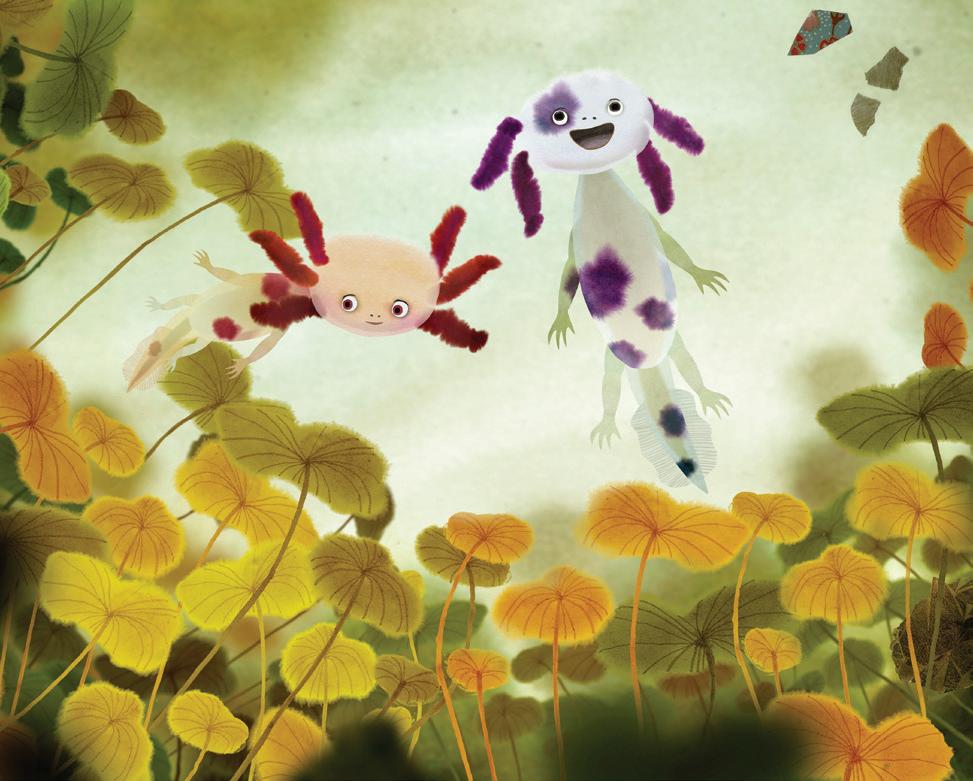
What is not to love about a charming 2D-animated movie about a young girl’s beautiful friendship with a clever dog during a summer seaside vacation? Perfect for the younger set, Basia and a Doggy Summer is based on a popular book series by Polish children’s author Zofia Stanecka and is directed by Marcin Wasilewski ( Rock Bottom, Lost Senses ) with a script by Szymon Jachimek. The 75-minute feature is produced by Robert Jaszczurowski (Grupa Smacznego/GS Animation) and co-produced by Ilan Urroz (Foliascope) and Agnė Adomėnė (Lithuania). Two paws up, for sure!
We are hoping that this movie helps push the colorful amphibians known as axolotls to the heights of pop culture fame! The new Czech-Norwegian co-production directed by Filip Pošivač ( Tony, Shelly and the Magic Light) follows a young misunderstood axolotl named Axl who runs away from home and finds himself trapped in captivity. The good news is that his adventures lead him to a better place as he forms lasting friendships with several eager crabs and is finally reunited with his family after a series of incidents. The 2D-CG animated feature, which is produced by Barbora Chabernoa (Bionaut) and Erik Smidersang Slåen (Fenomen), features appealing character designs and a charming cast of characters. You don’t have to be a savvy salamander to cheer for this project in development.

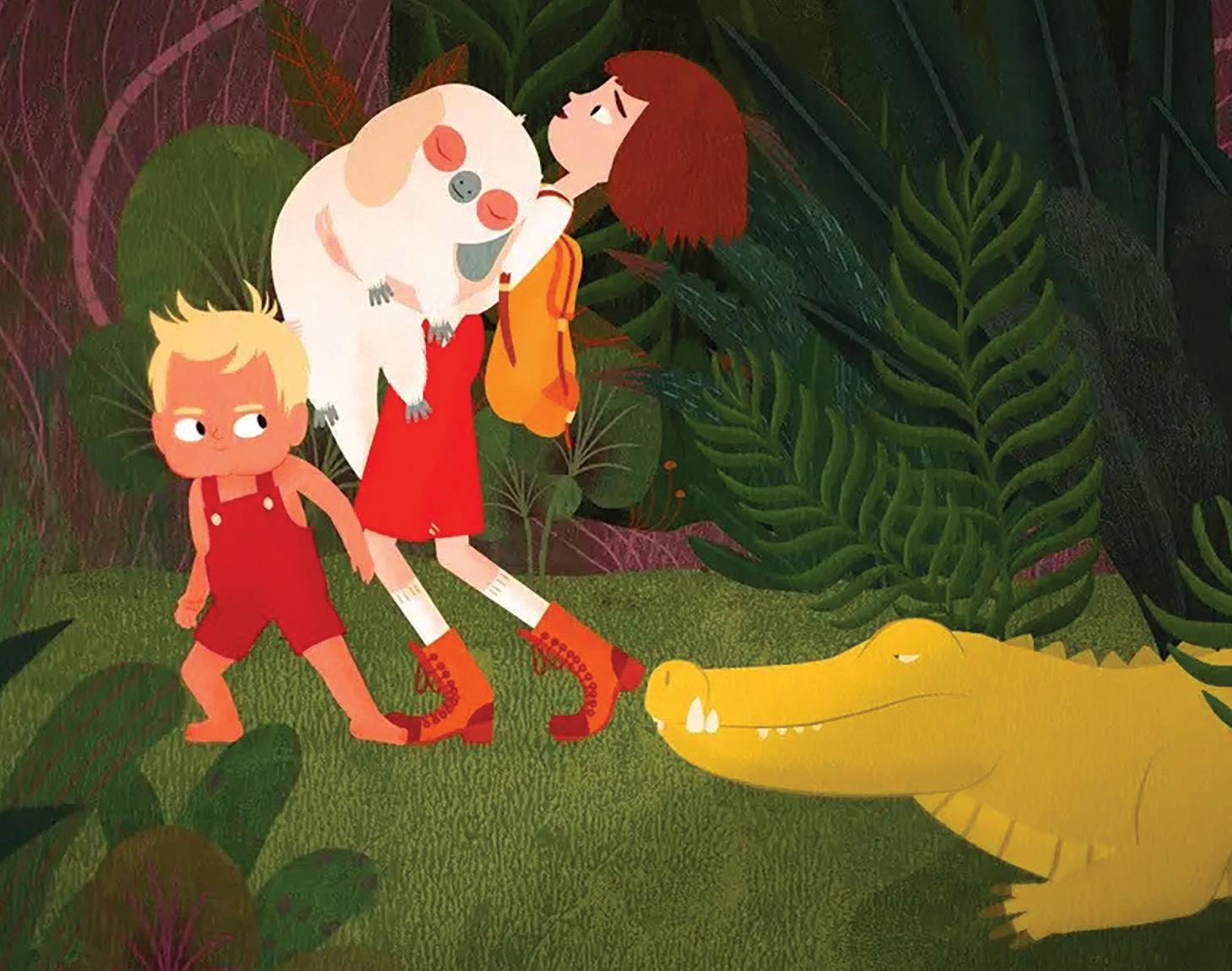
Latvian director Edmunds Jansons is no stranger to Cartoon Movie. His last movie — Jacob, Mimmi and the Talking Dogs — was a big hit at the event a few years ago. He brings another promising new title to Bordeaux this year: Born in the Jungle, a beautifully drawn feature about a girl who must find her younger brother after he disappears in the rainforest during a family vacation. Adding a bit more mystery to the plotline is a magical furry creature who lives in the Tepui mountains. The new pic is produced by Sabine Andersone (Atom Art) and co-produced by Letko veteran producer Piotr Szczepanowicz (Even Mice Belong in Heaven, Acid Rain), Vladimír Lhoták (Hausboot). Dandelooo is the film’s global sales agent. Thank God for these exciting family vacations that keep our eyes glued to the screen!
Bolivia’s recent political history complicates a young girl’s family that are affected by a multigenerational curse in writer/director Matisse Gonzalez’s fascinating new movie, Condenaditos (a.k.a. Cursed Children). The talented Bolivian-born director, who is based in Germany, has been a familiar face at Pixelatl and Ventana Sur, and her upcoming movie was also pitched at Annecy a few years ago. The 2D film is described as a “comedy for adults with autobiographical shades.” The FrenchGerman co-pro, which is currently in development, is produced by Stefan Michel (Studio Seufz), Nidia Santiago and Edwina Liard (Ikki Films). It definitely sounds like a labor of love that is worth the wait to see on the big screen in the years ahead.


A 10-year-old boy named Henry who lives alone with his father discovers that whenever his mother’s name is mentioned, violent winds appear out of nowhere and shatter everything around him (“Geist” is a German word that can mean ghost, spirit or mind). After a terrible accident at school, he realizes that it’s time to solve the mystery in the new 2D-animated movie How to Deal with Shattering Geists, directed and co-written by Kajsa Næss, who also directed the acclaimed 2022 feature Titina. The Norwegian-Dutch co-production is produced by Lisa Fearnley (Mikrofilm) and Janneke van de Kerkhof (Submarine Animation) and is being presented at Cartoon Movie in concept stage.
This poetic 2D-animated French feature charts the journey of an imaginative young African girl whose journalist father is forced to flee to Europe after soldiers attack him at his radio station one day. “I am a flying fish, and I help my father cross the skies, deserts and seas, guiding him on his journey to Europe…,” says the movie’s heroine. Based on a book by Cartoon Movie favorite Christophe Erbes ( Ella, Oscar & Hoo ) and Alpha Kaba , the 75-minute film is directed by Susanne Seidel, an animation veteran who has worked on acclaimed projects such as Sirocco and the Kingdom of the Winds and We’re Going on a Bear Hunt. The intriguing French project (in development) is produced by Patrice Nezan (Les Contes Moderne).


There’s always a good reason to celebrate when Latvian-born, Brooklyn-based auteur Signe Baumane embarks on a new project. The talented writer-director, who is best known for shorts such as Teat Beat of Sex and award-winning features Rocks in My Pockets and My Love Affair with Marriage, will bring her third feature-length project to Cartoon Movie this year. Karmic Knot is described as an epic chronicle of the life and times of a tightly knit family in Latvia that make a fortune by growing and selling rose cultivars. As the Soviet Union starts to fall apart, the family’s fate also changes, and they lose all their savings when the currency collapses. This semiautobiographical tale is bound to have the director’s trademark mix of poignant dramatic points and universal humor. The 90-minute feature will mix 2D, CG and stop-motion animation and will be produced by Dominiks Jarmakovičs (Latvia’s Studio Locomotive) and Sturgis Warner (U.S.), who also produced Baumane’s previous films. In short, a truly distinctive movie worth keeping an eye on.
A young goat named Lou, her brother Koa and their mother Zoe are at the heart of Frédéric and Samuel Guillaume’s intriguing new CG-animated movie. Lou and the Glacier’s Secret (L’Hiver de Lou) follows the mystical adventures of a goat who loses her mother in a terrible storm during their autumn migration. After encountering a mysterious creature, Lou learns the secrets of the spirit world around her and finds herself carrying on the storytelling traditions of her mother and those before her. The Franco-Belgian-Swiss production is a joint venture between Gao Shan Pictures (Arnauld Boulard, whose many credits include Into the Wonderwoods, My Sunny Maad, Funan and They Shot the Piano Player), Cine 3D (Samuel Guillaume) and Need Productions (Anne-Laure Guégan).
A Colombian eight-year-old girl named Hilda, her father Bonifacio and their pet pig Tulipán are the emotional centers of promising new title My Dad the Truck. Directed by María Cristina Pérez González, the 2D-animated movie follows the adventures of the trio as they leave their fire-ravaged farm in the middle of the Colombian mountains to search for a better life in the city. Hilda hopes to be reunited with her mother, while Bonifacio hopes to become a truck driver to rebuild their lives. The Spanish-French-Colombian project has a very strong pedigree: I t’s produced by Diego Herguera Acosta at Sultana Films (Sultana’s Dream); Ron Dyens (Sacrebleu), who also spearheaded acclaimed titles such as Flow, My Sunny Maad and Marona’s Fantastic Tale; and Mauricio Cuervo (Pez Dorado Animaciones). In other words, un viaje realmente fascinante!


“I want to make this movie because I would love to be the main character, who has a clear heart and the strength to lift everyone,” says Latvian director Karlis Vitols ( Minotaurs) of his latest project, The Northern Star The main character in Vitols’ movie is Nicholas von Himsel, an 18th century adventurer who embarks on a European tour to curate a cabinet of curiosities, meeting fascinating characters along the way. The 72-minute LatvianFrench co-pro is produced by Sniedze Kale (Studija Kokles) and Claire Matz (Yabunousagi). It sounds like a wonderful animated trip worth taking.
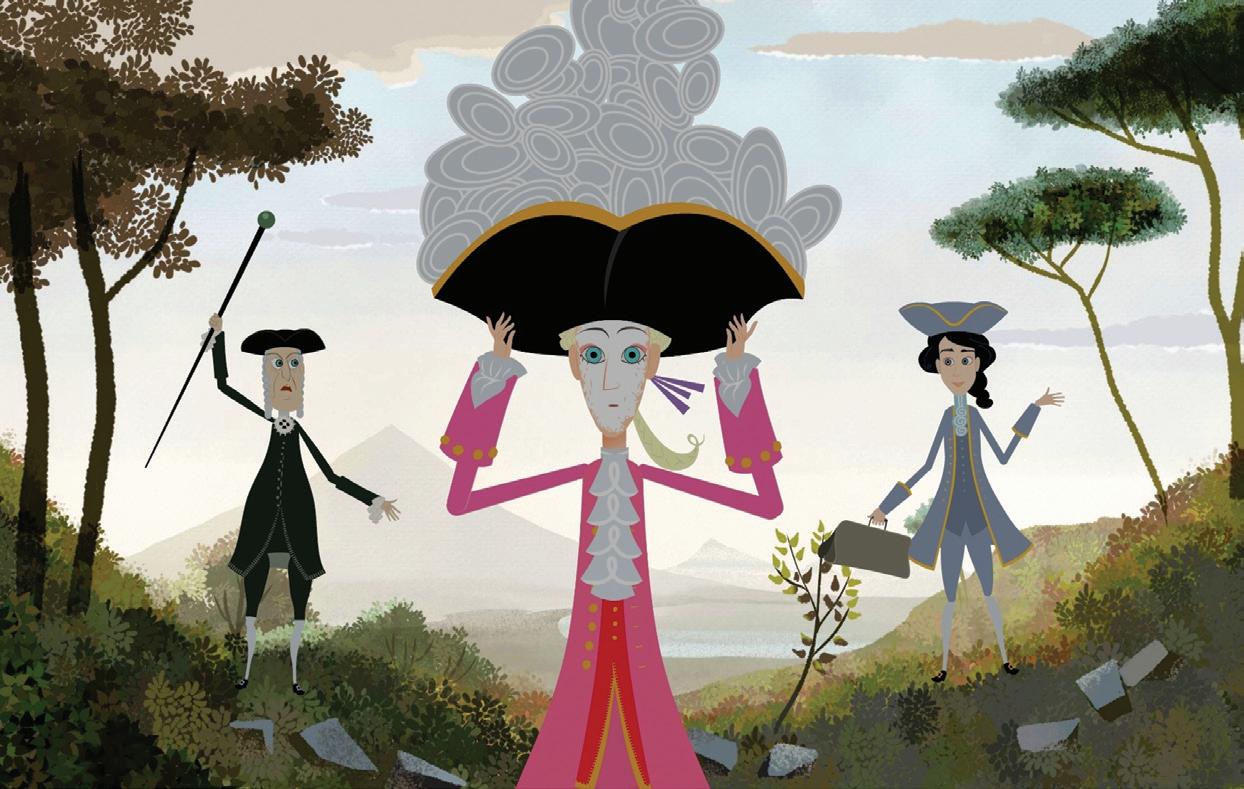
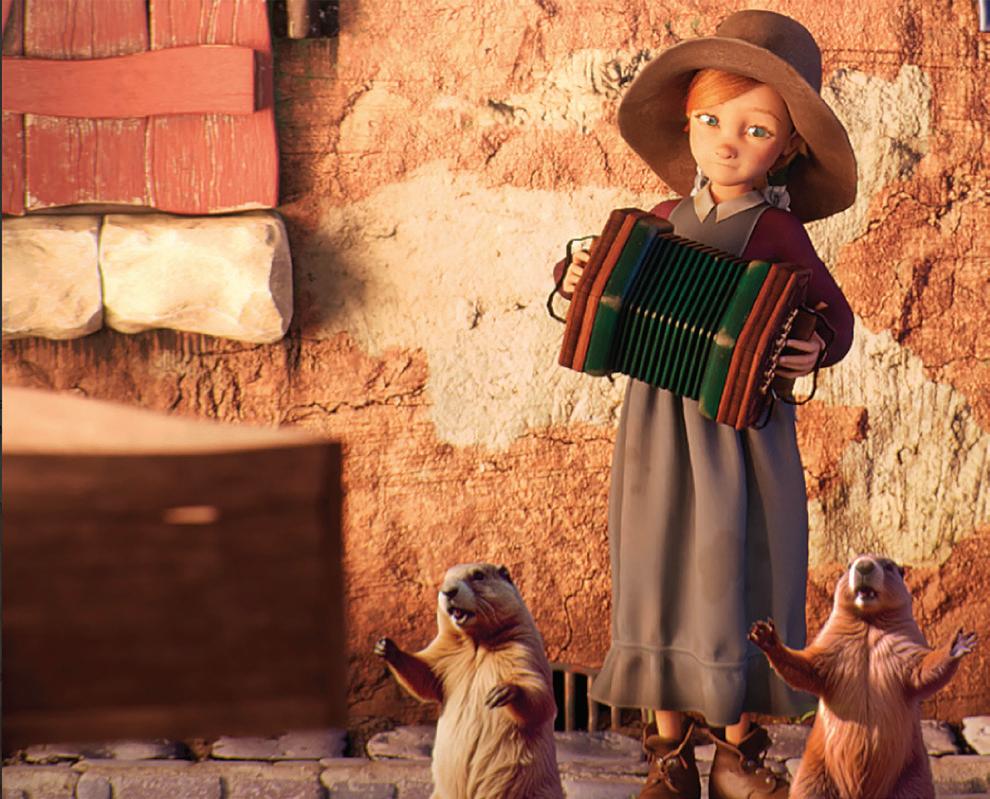
After making a big splash with his 2022 stop-motion feature No Dogs or Italians Allowed, French helmer Alain Ughetto is back at Cartoon Movie with another period piece. Rose and the Marmots, a French-ItalianPortuguese co-pro tells the tale of resourceful 12-year-old named Rose, who lives with her blind grandfather in a harsh mountainous terrain. To make ends meet, Rose leaves her grandfather behind and travels to the big city and makes a leaving by performing with her trained marmots. The script is penned by Alexis Galmot, who also wrote the screenplay for Ughetto’s previous movie. The innovative movie’s producers are Alexandre Cornu (Les Films de Trambour de Soie), Shiraz Bazin-Moussi (WeJustKids), Enrica Capra (Graffiti Film) and Luis Correia (Ocidental Filmes). We can’t wait to see this Dickensian, CG-animated movie, Monsieur Ughetto: You had us at trained marmots!
Three children make up their own stories when they spend the night at their grandfather’s house in the charming stop-motion movie based on Czech author Arnošt Goldflam’s book. Tales from the Magic Garden, which premiered at this year’s prestigious Berlin International Film Festival, combines elements of fantasy and humor and pays tribute to the power of imagination. A co-pro between Maurfilm (Czech Republic), Artichoke (Slovakia), ZVVIKS (Slovenia) and Vivement Lundi! (France), the anthology is produced by Martin Vandas, Alena Vandasová, Juraj Krasnohorsky, Henrieta Cvangová, Kolja Saksida, JeanFrançois Le Corre and Mathieu Courtois. The ambitious project’s directors are David Súkup, Patrik Pašš, Leon Vidmar and Jean-Claude Rozec. “Children’s programming often avoid the topic of death for fear of evoking negative emotions, leaving children who experience a loss feeling isolated, as if no one acknowledges what has happened,” says Rozec (Tadpole). “Despite the creative and financial risks, the producers decided to approach this sensitive topic in a careful and thoughtful way, and that’s why this film is so important to me.” n
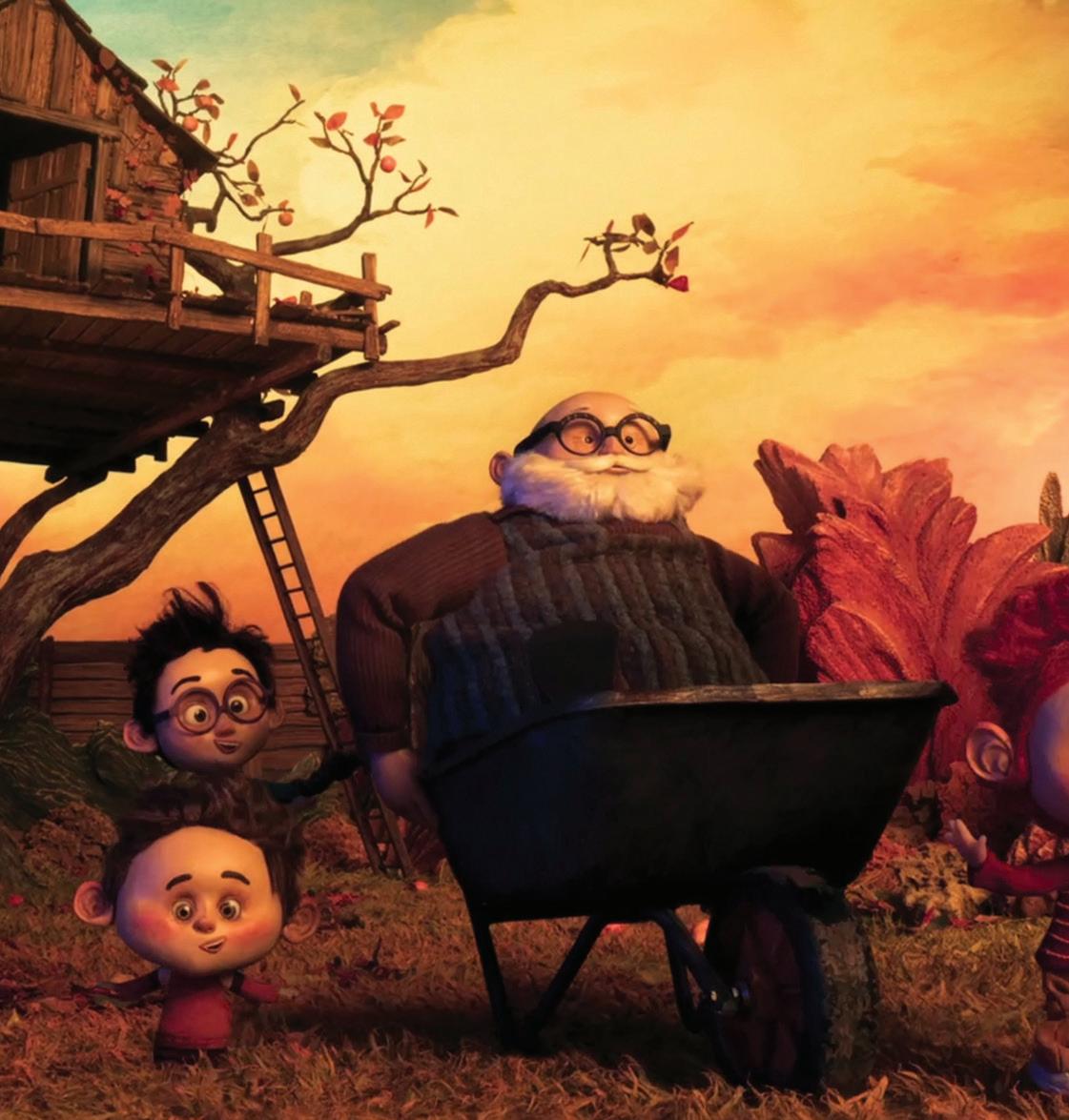




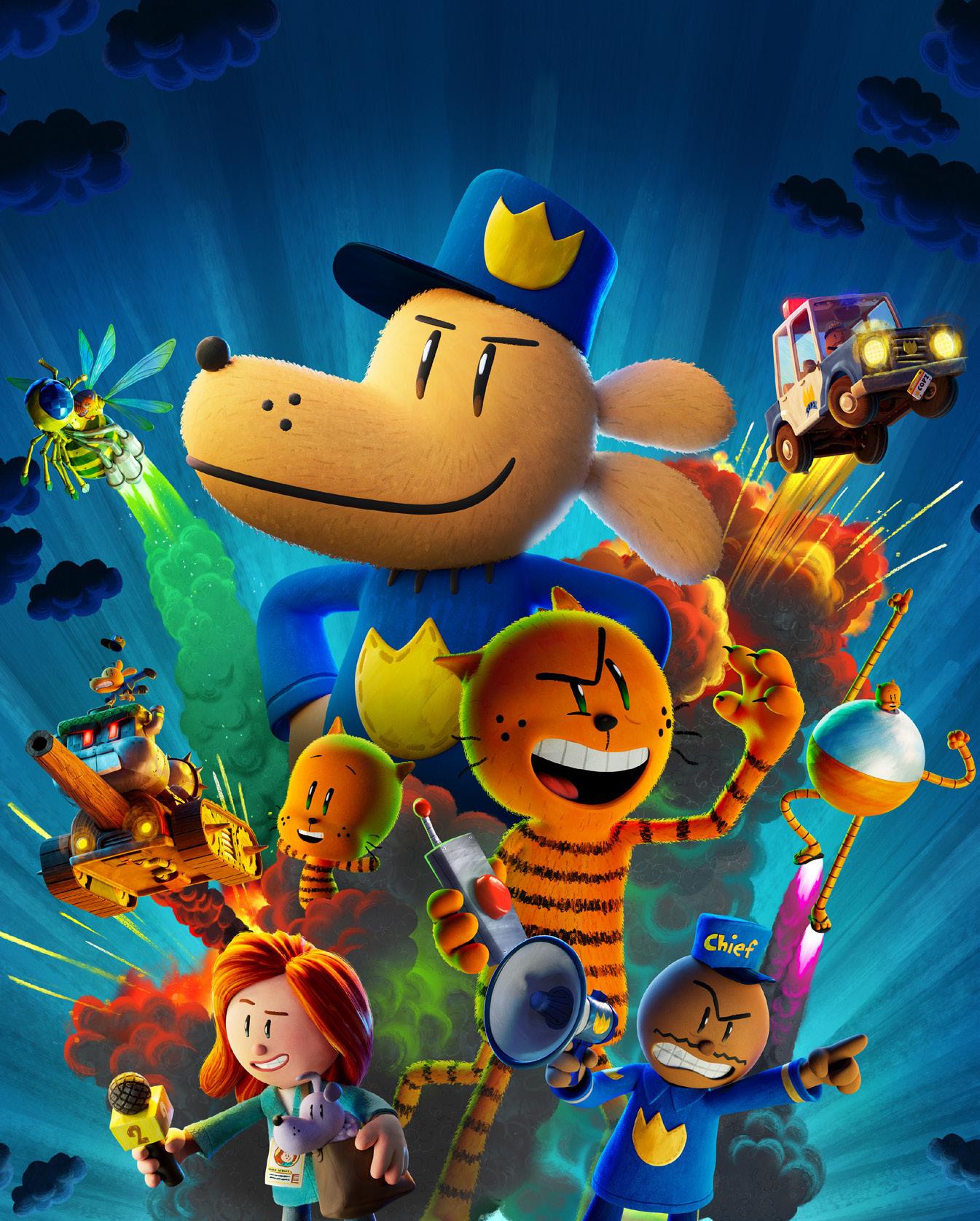

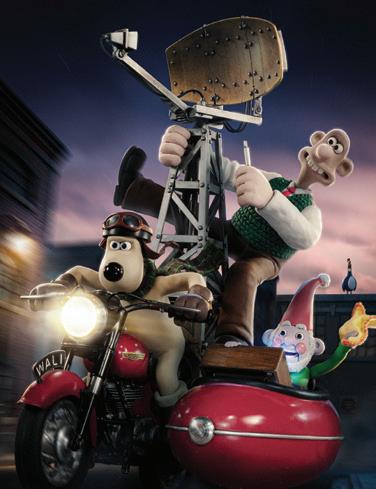
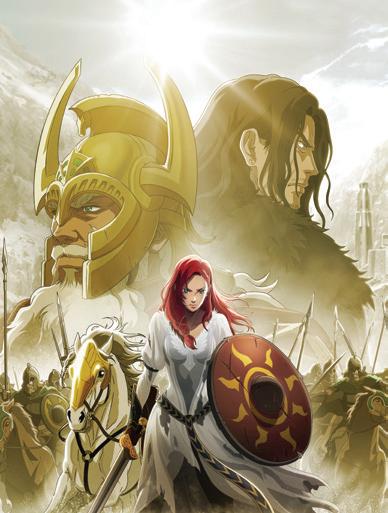




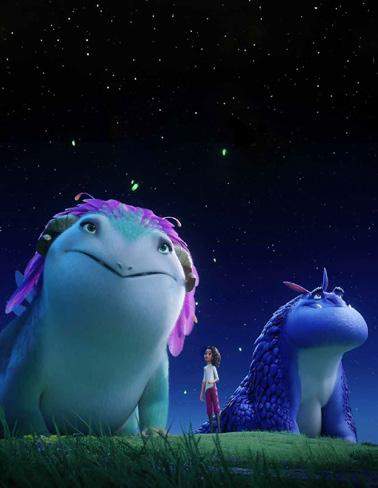

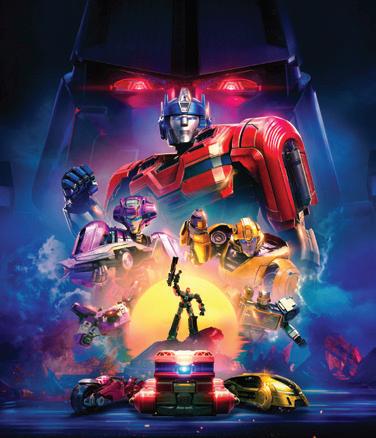
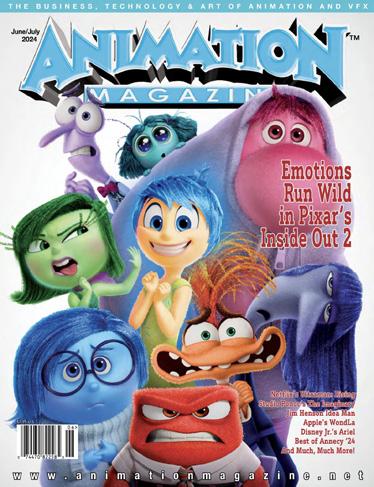




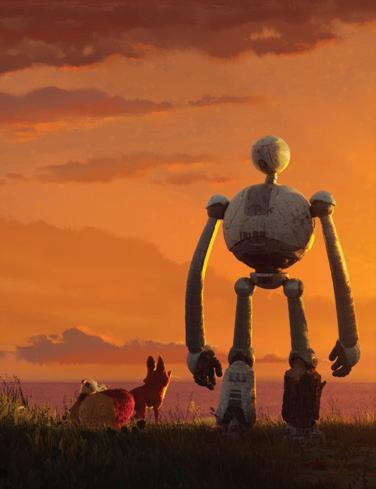
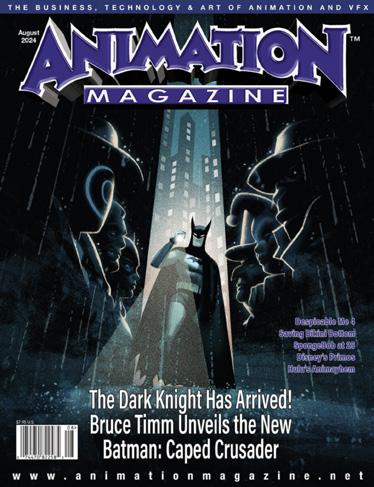


A recent book examines the importance of the detailed yet whimsical architecture in Studio Ghibli’s finest movies.
By Charles Solomon
Audiences associate the films of Studio Ghibli with their evocative depictions of nature: the summer rainstorm in My Neighbor Totoro, the forest ruled by the Deer God in Princess Mononoke, the woodlands that the tanuki (Japanese raccoon dogs) fight to save from bulldozers and concrete in Pom Poko
Available for first time in English, Studio Ghibli and Architecture in Animation (VIZ Media, $35) from the “Studio Ghibli Structures Exhibition” (Ghibli no Rittai Kensobutsu Ten Zuroku , 2014) examines the importance of architecture in Ghibli films. The reader discovers the history and thought behind Ashitaka’s village in Princess Mononoke ; the arrangement of the rooms in Seiji’s grandfather’s house and Shizuku’s family’s apartment in Whisper of the Heart; and the formal Heian-era gardens and palaces in The Tale of Princess Kaguya
Most of the text is a sort of dialog between Hayao Miyazaki and Terunobu Fujimori, a noted architect and director of the Edo-Tokyo Museum. Each comment is marked with a small caricature: Fujimori with neatly parted hair and glasses; Miyazaki as his trademark pig, now sporting a bristly white moustache.
Reflections of the Residents
Miyazaki and Fujimori examine questions about structures in the films in different but complementary ways. As the founder of
the Architectural Detectives group, Fujimori wrote about the kanban-kenchiku (billboard architecture style), which was built during the push to modernize Tokyo during the Meiji era (1868-1912).
Miyazaki explains that’s he’s less interested in buildings than the people who inhabit them. He imagines the history of a decrepit kanban-kenchiku shop with a cheap sign that stands among the restaurants and souvenir stalls around Yubaba’s bathhouse in Spirited Away. “We can consider many aspects of the shop even now — how excited the owner must have been when it opened,” he says. “How they harbored the hope it would be a hit. We can wonder what they gave out at the shop’s opening celebration.”
The deeply human focus of that analysis reflects Miyazaki’s approach to his art. Creating that detailed backstory enables him to imbue the shop with life when Chihiro and her parents see it. Whether it’s part of a derelict ghost town or a bustling resort for weary nature spirits, this building isn’t just a backdrop. It’s an essential part of the world Miyazaki is creating, a world inhabited by living characters who interact with their environment.

“The images are simply fabricated inside of me. That is how location scouting is for me as well, it’s basically all fabrication. I go to the locations not to investigate them but to decide how much I can lie about them.”
DIRECTOR HAYAO MIYAZAKI
In addition to his learned explanations about architectural styles and history, Fujimori notes that the buildings in the Ghibli films are so carefully designed, they could easily be constructed in real life. He confesses that he wants to build the ramshackle, steampunk title structure in Howl’s Moving Castle: “At first glance, it looks like a complicated oddity that could only exist in fantasy, but you could actually build it if you tried.” Fujimori says he would have to use “the incredibly strong material called single-crystal iron,” but concedes, ”it would be difficult to make it walk or fly.”
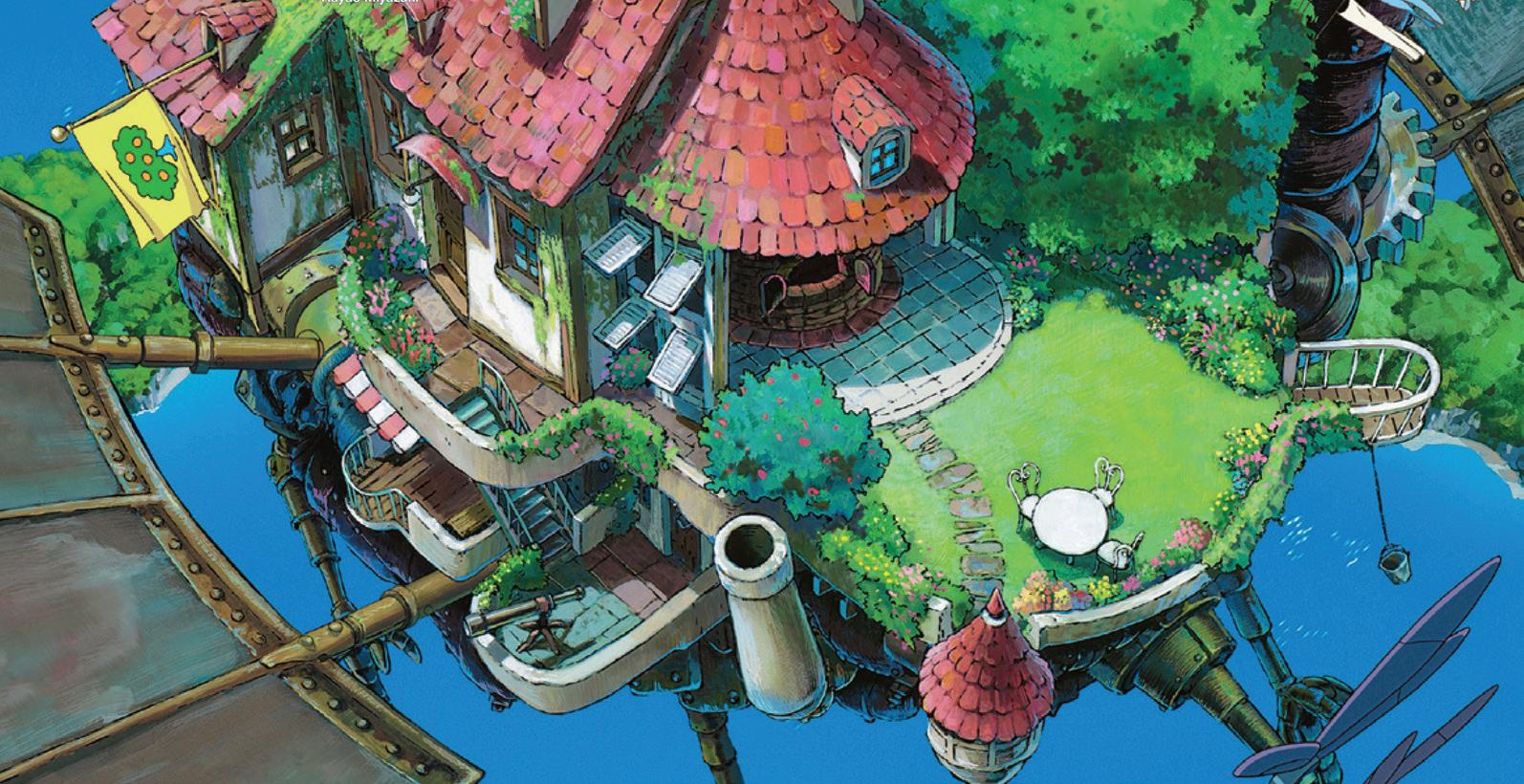
Miyazkai pokes gentle fun at the stylistic mishmash of the city where Kiki and Jiji move in Kiki’s Delivery Service. “This is how the Japanese imagine an old European city,” he comments. “There are elements of Naples, Lisbon, Stockholm, Paris and San Francisco all mixed in, so one side faces the Mediterranean while the other faces the Baltic Sea.”
The back-and-forth discussions also help the reader understand the details of architectural styles unfamiliar to Western
readers. Fujimori explains that the Latin Quarter in Goro Miyazaki’s From Up on Poppy Hill is an example of the Giyōfū pseudoWestern construction style, modeled on public buildings that the first magistrate of the Yamagata region had erected as symbols of the modernization of Japan at the end of the 19th century. The clapboard walls, pedimented windows, elaborate staircases and what was once a gas-lit chandelier emerge when Shun, Umi and their friends clear the structure of decades of abandoned student projects.
Although Miyazaki clearly respects Fujimori’s work and has done extensive research in Japan and Europe, he irreverently says of his films, “The images are simply fabricated inside of me. That is how location scouting is for me as well, it’s basically all fabrication. I go to the locations not to investigate them but to decide how much I can lie about them.”
The building that receives the most attention is the slightly gone-to-seed house in the countryside that Mei, Satsuke and their father move to in Totoro. Fujimori describes it as “a somewhat fashionable office worker’s house from the Showa period (1926-1989).” He goes on to describe how the structure incorporates Japanese and Western elements and how the interior space would be configured.
Miyazaki replies, “When my brothers saw this house, they said, ‘What? You put our house in it?’ It was located in the Eifuku



neighborhood of Suginami, Tokyo, but has long since been torn down. This is a memory of that house.”
Fujimori discusses the details of the house — the roof, shutters, doors, tiles. But Miyazaki has the last word and once again stresses the human aspect of his vision. He says he wanted to “create a place people would want to live.” He recalls that when the staff saw the rushes for the film, no one commented on the animation:
“They would instead say, ‘I wish I lived there.’ [laughs] No one wants to lower their standard of living, but they would want to live in a place like this if they could. That feeling has fairly deep roots. With the water, trees and space, you think how lovely it must be to live there, connecting with kind neighbors — this desire seems to be innate in our hearts.”
The desire to live in harmony with nature during the four seasons of the year has been
an essential theme of Japanese culture for centuries. Time and again, Miyazaki has combined traditional values with his artistic vision to create places where audience members, like the staff artists, wish they could live. n
VIZ; $35; 192 pages by Terunobu Fujimori and Hayao Miyazaki is currently available online and major bookstores.

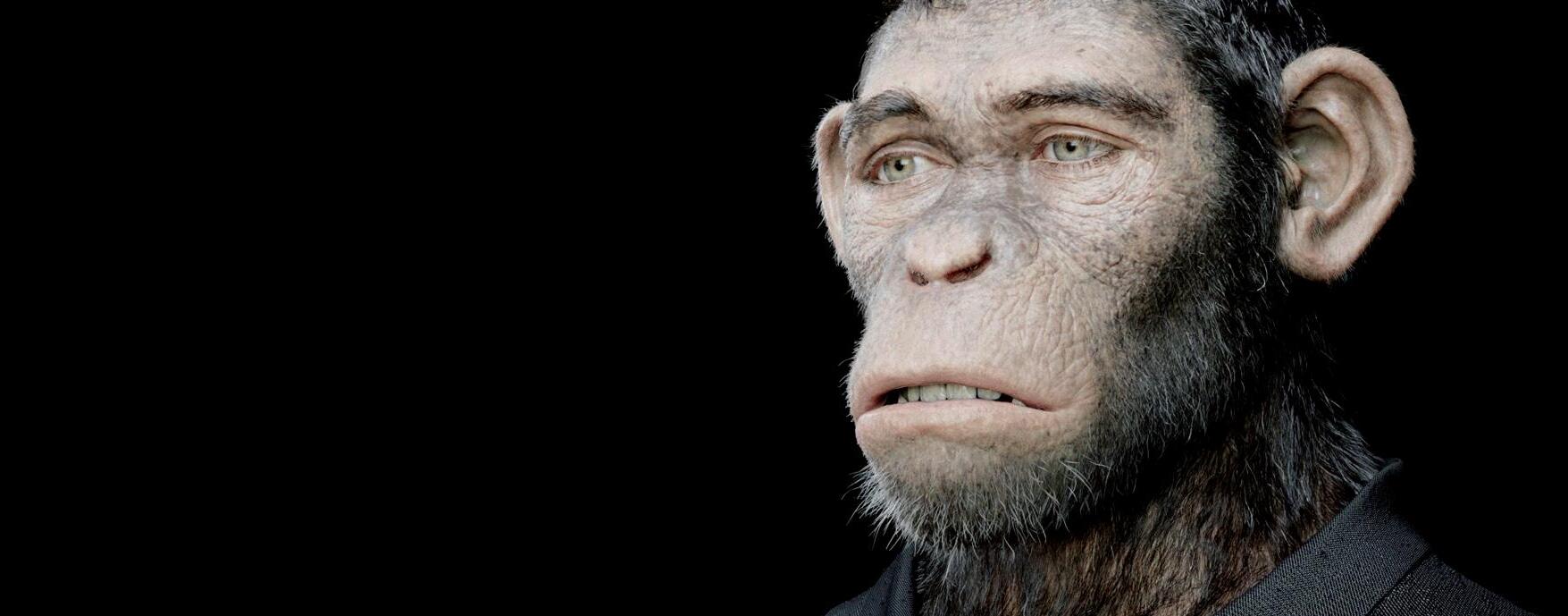
By Trevor Hogg
In an era when sequels dominate the global box office, there are still studios and filmmakers willing to push the boundaries of storytelling beyond established franchises. Such is the case with Paramount Pictures and director Michael Gracey ( The Greatest Showman ), who set out to deliver Better Man, a biopic on British pop star Robbie Williams that features a CG version of the artist as a primate.
To avoid the movie coming across as just a gimmick, actor Jonno Davies was recruited to do the motion-capture performance and the CG protagonist was crafted by Wētā FX, an expert in this field that has done work on The Planet of the Apes , The Umbrella Academy and King Kong
“With The Planet of the Apes, these characters are slowly evolving from chimps to become more humanlike, but they’re not human yet,” says Luke Millar, VFX supervisor at Wētā FX. “Whereas this one is right up the other end
of the spectrum. Everything Robbie does in the film is essentially what a human does, he just has an ape representation.”
In this lovingly crafted biopic, Williams appears as a child, teenager and adult. “We did have some younger actors helping us motion capture the young Robbie, but also we had Jonno throwing in some performances here and some references,” says Dave Clayton, animation supervisor at Wētā FX. “That was more of keyframe job. As a boy, he’s a showoff and cheeky but still has that insecurity which plagues him throughout his whole life. He later grows into a teen with much more false bravado. He’s trying to prove himself, mainly to his dad. When he matures, he suffers the pitfalls of fame, addiction, mental health issues, and is struggling up against that and his skyrocketing fame. We worked with this amazing footage from Jonno. That’s not to say we didn’t augment it. There are clips of Robbie everywhere throughout his life. We sourced little smiles, cheeky looks, little actions that he would do, and embellished our Robbie Ape with these real-life historical moments which elevated the character.”
Costumes and fur were treated as though

they were characters in the movie. As Clayton explains, “Without those feeling completely tangible, real and interacting properly, the character is not going to feel real anymore, and we don’t want it to be a gimmick,” remarks Clayton. “We weren’t saying, ‘Here is a caricature of a monkey amongst all of these live-action actors.’ We’re saying, ‘He’s in there with them.’ If his costume didn’t hang or crinkle or light the same way, you’re going to isolate him as a CG intruder. Some shots where he’s dancing in Regent Street, side by side with the Take That boys, his costume looks as every bit of real as theirs does.”
The film’s most complicated interaction takes place during the “She’s the One” scene. “It’s an intricate dance number between Robbie and Nicole Appleton,” explains Millar. “There are lifts and spins. They literally touch each other in every single shot. To do that, we had a detailed match-move of Nicole, and then Dave started animating Robbie to where Nicole is, but that still doesn’t take into account the costume. There’s a lot of back and forth with moving the hair and re-simulating it; that goes most of the way there. Then we end up sculpting things around the fingers to make sure that connection is 100% believable, because if it’s


not it will be the first thing people will spot.”
Not only did Ape Robbie have to speak — he also needed to sing. “I learned a lot about breathing, which is a huge part of a singing performance,” explains Clayton. “I was focused on making sure that you saw our character’s shoulders and chest slightly deflating and letting the air out. Singing is not just [about] the way the mouth is but the way the whole body engages. In the ‘Let Me Entertain You’ sequence, he’s belting it out to a crowd of 125,000. Whereas in one of the first musical numbers, like ‘Feel’ or ‘Something Beautiful,’ he’s vulnerable and quiet, almost whispering some of the lines. We had a full array of singing types.”
Over the course of his career, Robbie Williams’ appearance has evolved, so the same had to be true in the biopic. “Obviously, Robbie has got a rich history in terms of the looks that he has had throughout the years, and he has accrued a number of tattoos throughout
“We weren’t saying, ‘Here is a caricature of a monkey amongst all of these live-action actors.’ We’re saying, ‘He’s in there with them.’ If his costume didn’t hang or crinkle or light the same way, you’re going to isolate him as a CG intruder.”
DAVE CLAYTON, ANIMATION SUPERVISOR
his career as well,” says Millar. “We wanted to represent that historical parity between Ape Robbie and Real Robbie. With the tattoos, we came up with the idea of rather [than] actually tattooing ink under the skin, as you would, why don’t we shave the tattoos into his fur like hair art? We went through a number of iterations and had tattoos in stages, because he didn’t get them all done in one go; Robbie got them done over a period of time, so we accumulate them. It worked well. It lent itself to the chimplike character and was also a nice take on how to tattoo a chimp.”


In order to emulate concert lighting properly, the pipeline had to be overhauled. “The thing about concert lighting is it’s repeatable and programmed into a lightboard,” says Millar. “The lightboard operators always give us their files, but we can’t do anything with them. When you’re dealing with a concert, there are about 100 different light fixtures that are all being controlled to music timecode. I sat down for a long time with the physical lighting team and learned as much as I could about their software and how we could re-create what they’ve done within the computer. There were some things that we couldn’t do, but we had to come up with alternatives. Their software doesn’t care where this thing lives within space, whereas we need to know where these things are. We shot LiDARs where the lights would be and HDRIs to know [about] the exposures and colors of the lights. We wrote a pass to import the lighting software information and then rebuild those lighting concerts within the computer. Given that they’re all timecoded as well, it meant that we were essentially retiming the timecode of the song slightly to that moment. We would get all of the lights in the same position. That was a real win.”
Around 2,000 extras were brought in for the iconic Knebworth Park concert scene. “When they started arriving, I went, ‘Oh, my God, this is so many people,’” recalls Millar. “And then they clustered them around the stage, and I was like, ‘That’s 2,000 people?’ But it was enough to do the close-ups and medium

stage shots and have everyone in camera. It was only when we went wide that we had to start fleshing out with the digital crowd.”
Afterward, 108,000 digital extras were added. “It was always important to Michael to make a convincing crowd because so often they can look fake,” says the supervisor. “We tried to put a lot of interest into them. People talking to each other or holding little cameras. An inflatable couch bounces around there quite a bit. We called it ‘crowd detritus.’ The other important thing is you couldn’t do a loop the whole time. We observed in the historical footage from the real concert that when Robbie goes, ‘Jump!,’ you can actually physically see the delay it takes for the sound to hit the people in the back versus the ones in front. The jump is like this pulsing wave that goes down outwards, emanating from the stage. We even simulated that motion into our crowds.”
In total, there were 1,968 visual effects shots, with 60 being entirely CG. “I hope that when people see films like Better Man it will encourage more projects like it. It’s enjoyable to push the creative envelope and not just the technical one, which is what visual effects tends to always lean towards,” observes Millar. “Seeing what you can do with that technology is exciting.” n
Paramount’s Better Man is nominated for an Oscar for Best Visual Effects. The movie is currently playing in theaters around the world.

By Todd Sheridan Perry
When the Substance tool kit moved over to Adobe, I didn’t realize that Substance Modeler was part of the package. So I was curious: Do I need yet another modeling tool? Is this something different than what I’ve been used to? The
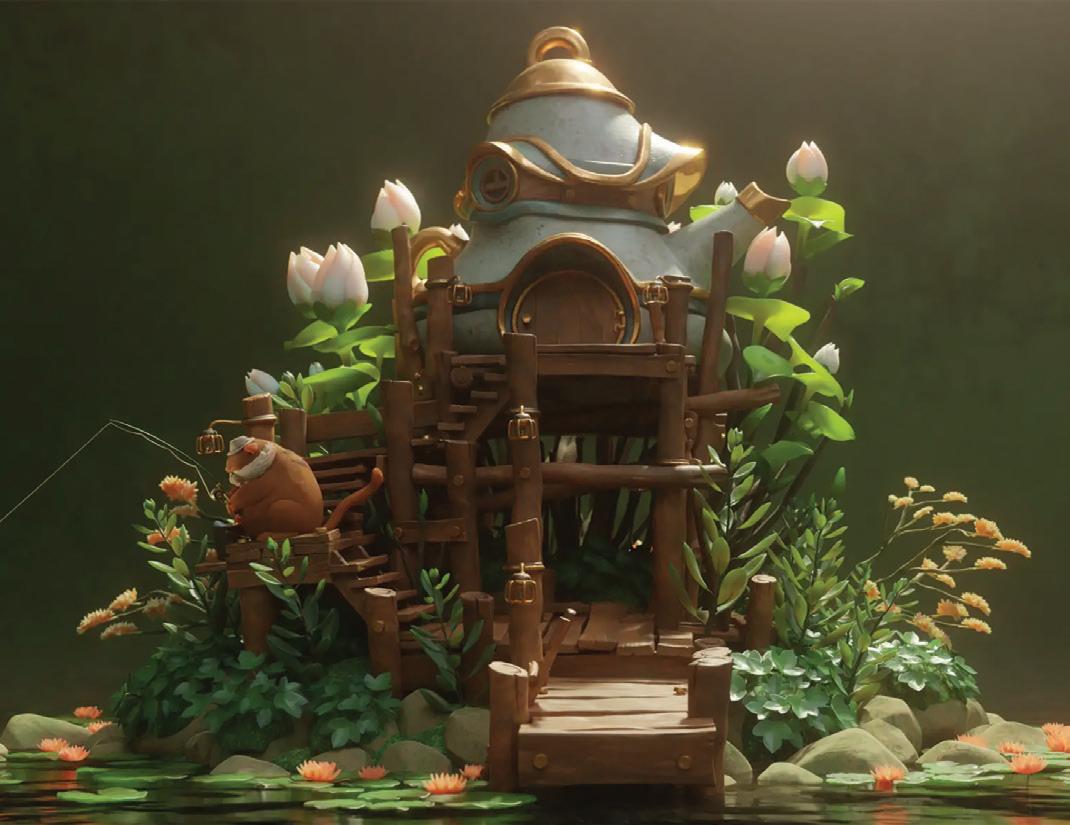
answer is yes. Even though the foundation technique is not so new, it has gained popularity in recent months.
Substance Modeler is an SDF (Signed Distance Field) modeling technique. Without getting into the nitty-gritty of the math, let’s just say it’s kind of like fluid simulations in that your calculations are made within a voxel volume. But instead of calculating dynamics, you are building polygon-less surfaces, with the primary methodology being Booleaning basic shapes together to create more complex ones — and it includes additional tools and functions for sculpting and smoothing those surfaces. That’s the very nuts and bolts of it.
Substance Modeler lives in a medium referred to as “clay,” which is what your models are made from. In any particular “layer” of clay, you can use primitive shapes to build up or subtract from one another to construct your form. These will Boolean together to form a

cohesive shape that can be smoothed, warped or flattened with manipulators and brushes. You can also make cuts and extrusions and then split them off into a separate layer to be adjusted separately. Furthermore, there is symmetry, instancing and array tools to easily create multiple shapes, all still kept live and linked to one another as you continue to add detail. Also, it’s not only shapes: You can use brushes to apply detail as stamps, much like ZBrush.
All this functionality, one could argue, has been a part of 3D-modeling tools since forever, and one would be right. But it’s the SDF math that makes the workflow different. Since your resolution is voxel-based, you can work at a lower resolution and then increase the voxel count to smooth things out. This keeps Modeler very responsive, even as the model gets more complicated. And, because you aren’t dealing with polys, the mushing together of the geometry is very clean, even with really odd and crazy surfaces where traditional Booleans would splinter and break. But therein lies the rub. All of the surfaces
remain essentially uniform — if you look at it from a polygon standpoint. So, when you export out to a traditional workflow as USD or FBX, or a slew of formats, although you will have control over your poly type, count and even how much it will adapt to the topology — you are not going to have the best edge flow. That said, the model could be passed to an excellent modeler to retopologize (modifying or re-creating a model’s polygonal mesh to make it cleaner and more efficient) it in the user’s software of choice.
Substance Modeler is fast and responsive, and I think it is fantastic for prototyping and doing conceptual modeling or making things to be 3D printed. It’s less useful when you need to be really precise or are planning on bringing models directly into an animation pipeline. I can see it hitting limitations if you want to make huge models with tons of detail, simply because, like in fluid simulations, the larger and denser the voxel volume, the slower the response and the more RAM you use. That’s pretty slick — and you know what!? You can also use it in VR. n
Website: adobe.com/products/ substance3d.html
Price: $49.99 per month
As with the other Adobe Substance suite tools, I haven’t had a chance to review Painter since Allegorithmic was acquired by Adobe, so a lot has changed.
Again, a quick overview: Substance Painter has for nearly a decade been a key go-to painting tool for games, animation and VFX. Even with a slew of 3D paint tools that had a head start, Painter quickly caught up to them. I suspect that some of it was because of the intuitive nature of the workflow, but it’s also because of its texture-baking tools to extract normals, occlusion, vector and position data from 3D surfaces — which was key to hi-poly/low-poly workflows in games but was quickly recognized as a benefit to 3D in film as well. It’s a layer-based system, very much like what we were used to in Photoshop, so it had an easy learning curve. Regardless of the reasons, Substance Painter has become ubiquitous. The 2025 release primarily focuses on incorporating vector-based imagery into the workflow. The benefit, as I see it, is being able to maintain the fidelity of the graphics, which risks getting lost when it is rasterized after being exported to a bitmap for texturing. Illustrator files are now supported, which is an obvious move given that Illustrator and Substance
Painter now live in the same household, if different wings. The less obvious benefit is that within an Illustrator file, you have artboards that can hold a bunch of different images in one file, which can be accessed and made into different layers within Painter.
Related to vectors is a path tool, which was introduced in 2023 but updated in 2025. The tool is a combination of vector and raster in that a vector path can be drawn on a surface, which is used to inform where raster textures would flow on the surface — and then that path remains live so that adjustments can be made later.
Fonts are also in the vector wheelhouse. You can drop system fonts onto surfaces and not only keep the fidelity of the font but audition different fonts or font styles by rasterizing and baking them in.
Interoperability is critical to the entire Substance suite, and Substance Painter is no different. It certainly interfaces within the Substance ecosystem, but as a part of the AOUSD (Alliance for OpenUSD), Adobe is working to keep up with USD requirements. And, like Sampler, you are able to “Send To” external software through Substance Connector — but since Painter is primarily dealing with textures, the supported software is Photoshop and After Effects.
In its September release, loads of filters were added that included an embroidery decal material, path-based fill area, an FXAA filter for
Iam slightly ashamed to admit that the last time I looked at Substance Sampler was when it was called Allegorithmic Alchemist. It has certainly come a long way in the last five or so years, incorporating AI tool sets to augment the texture, material and object acquisition tools that were already on the development path. I’m not even going to have a sliver of enough space to cover everything, so I’ll have to cover the latest.
First, a quick overview is in order: I see Substance Sampler as partially a way to create assets (materials and models) through acquired physical samples — or through prompts (in beta), but also as a tool to generate materials as SBSAR files more intuitively and artist-friendly than its more involved sibling, Substance Designer.
The foundation functionality is to take an image (or a model from photogrammetry) and derive diffuse, roughness, ambient occlusion, height, normals, etc. The filters and procedures to refine the results are stacked up like layers that can be tweaked and modified to get the effect you like. And that result can be saved out as an SBSAR file, or as texture maps to use in your preferred flavor of PBR renderer. This includes the ability to expose parameters in the SBSAR file so that the material can be further adjusted when it gets to the host 3D package.
The latest version of Sampler allows you to use (as beta) the tech that is cross-developed within Adobe’s AI tools. So, along with textures, the image-to-texture process can be also augmented with machine learning. And there are Text-to-Pattern and Text-to-Textures functions that are prompt-driven. The results create variations of the prompt results, which can then be brought into the image-to-texture workflow, modified with the Sampler filters, and then brought back into the image-to-texture AI tool to generate additional variations of that material. Furthermore, text-to-patterns can be prompt-generated and fed into image channels of a ton of preset Substance assets.

reducing artifacting on masking filters, a new high-pass filter,pixelate filter, posterize filter, a new threshold filter and more advanced mirror and transform filters.
All of the Substance tools were tested on a high-end workstation provided by Puget Systems. n
Website: adobe.com/products/substance3d/apps/painter.html
Price: $49.99 per month (included in the Adobe Substance 3D Collection plan)

In the latest release as of July 2025, the primary advance for Substance Sampler is interoperability with external programs including Unreal, Blender, Maya, Max and Unity. So, from within Sampler, you can send the material directly to outside software as long as the Connector plugin is running. Each of the plugins is freely available to download for the hosts — except for Max and Maya — because the plugin is already built-in if you are using the 2025 releases. Please understand that I am simply glossing over the functionality of Substance Sampler; it goes so much deeper than I’m able to cover here. It is available in the Adobe Substance 3D Texturing suite, so if you aren’t using the rest of the full Substance 3D Collection and don’t have the budget for the full package — the time savings for Sampler may very well be worth the lower cost of 3D Texturing. n
Website: adobe.com/products/substance3d/apps/sampler.html Price : $49.99 per month (included in the Adobe Substance 3D Collection plan)
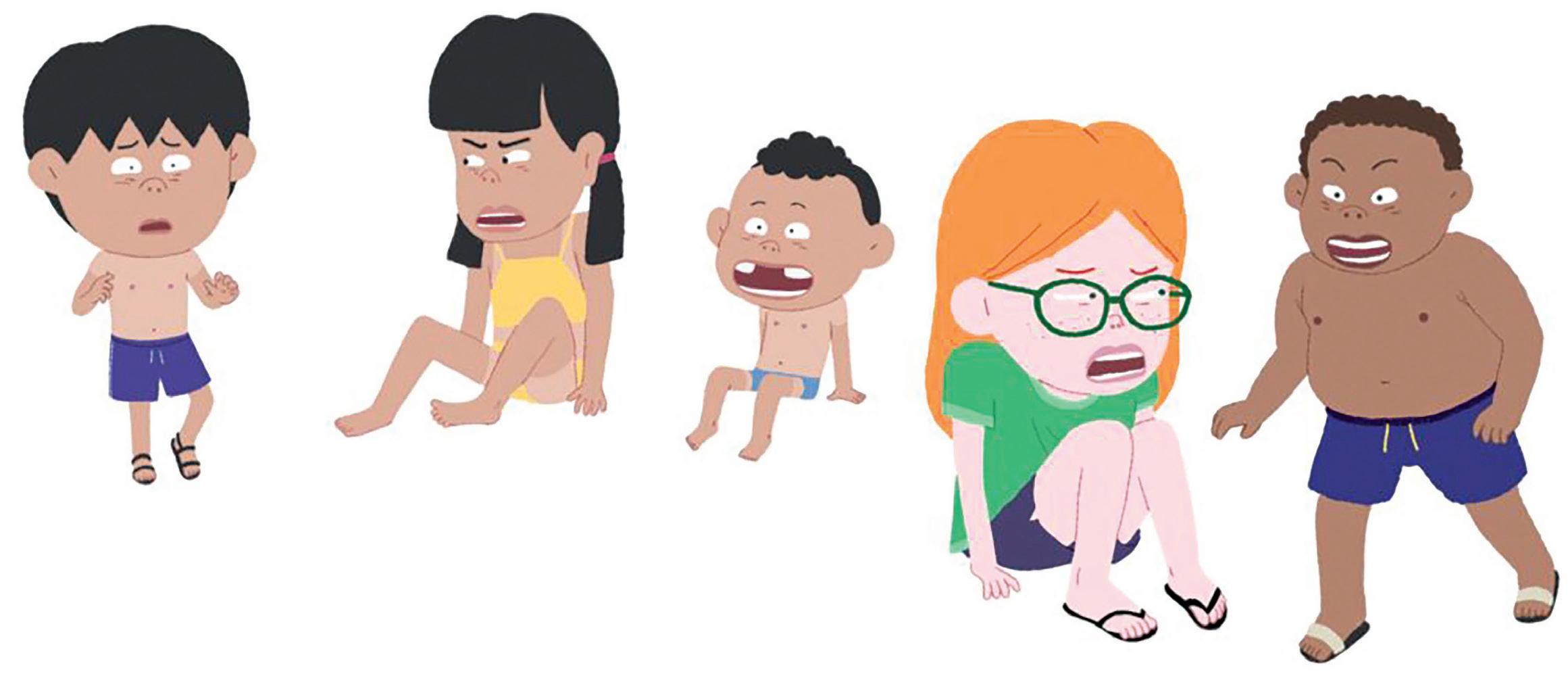
As in real life, the kids featured in director Loïc Espuche’s Oscar and Annie-nominated short Yuck! (Beurk!) believe that a kiss between grownups is a stomach-churning scene to witness. The talented French director, who was a storyboard artist on The Ollie & Moon Show and supervising animator on the 2017 feature Marona’s Fantastic Tale, was kind enough to answer a few of our burning questions about his acclaimed new short and his own childhood experiences:
Can you tell us a bit about the inspiration behind your short?
Loïc Espuche: I had the idea of making this film during a screening of my previous short film in a cinema full of children! At the start of the film, the main character was saying goodbye to his fiancée with a little kiss … At that moment, all the kids in the room started screaming: “Yuck! that’s so disgusting! they’re kissing!”
Their reaction both made me die laughing and took me back to my own childhood, when I too screamed in disgust at every kiss, while dying to kiss Sophie (my girlfriend at the time) … And I said to myself, “Wow, I absolutely have to make a film about kissing and all the reactions it can provoke for children.” That’s when the idea of the pink mouth came in, to symbolize the
desire to give a kiss. This concept allowed me to tackle with humor themes like the beginning of feelings, the fear of other people’s gaze and also about the notion of your own “secret garden.”
Can you talk about your visual influences?
I haven’t really tried to get close to any particular reference, but I’ve been told a lot that the characters look like the ones in Akira Toryama’s Dragon Ball And I think people are right! When I was a kid, it was my
favorite cartoon, and I spent hours and hours drawing San Goku, I think this subconsciously influenced my drawing, and that when it came to drawing the characters as a child and trying to make them expressive and accessible to all, my past as a Dragon Ball Z fan must have resurfaced!
More generally, I love Pixar and Ghibli animated films. Graphically, they’ve got personality, yet the drawing really serves the story, doesn’t try to steal the show and allows an extremely wide range of emotions

to be expressed. The character’s design is not quite naturalistic, yet we believe they really exist. When I watch these films, I forget about the technique and get caught up in the universe. I think that graphically I’m trying to move towards this approach. For Yuck!, some graphic choices have been made to specifically serve the story; the characters have no outlines to let the colors come alive. Moreover, all the designs are in solid colors to contrast the pink lips, which have a glitter texture to make them fascinating.
How long did it take to make this short and which tools were used to create it?
I spent five and a half years on this project, from the first idea to the final mix — about three and half years writing and funding it, then two years making it. The animation took eight months. We worked with TVPaint soft ware. I wanted the film to be hand-drawn because I find that drawing helps to summarize information, to remove anything that isn’t useful, so that we can focus on the essential.
How big was your team?
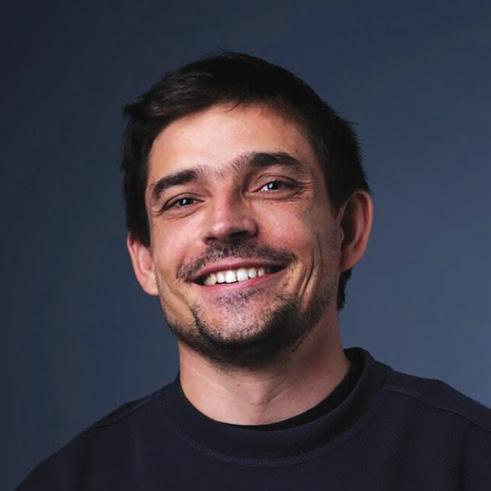
Around 60 people worked on the film, some coming in for just a few hours to record the adult voices for example. The animators all spent several months on the film. We were in residence at Ciclic animation (a truly unique institution) for the making of the film, and lived in a shared flat during the whole time. It was a magical time of life!
What do you love most about the finished product?
The audience’s reaction in the cinema is truly the best reward of all! What’s great is that the film really gets people of all ages, young and old, reacting. During school screenings, children react at the same time as the characters, shouting “Yuck!” Sometimes you can’t even hear the dialog anymore! Adult viewers often laugh, not only at the film itself, but also at the reactions of the children in the room! What I find great about all these audience

reactions is that they’re sharing the moment together. Seeing it in a cinema really adds value to the film.
During a Q&A with a school class following a screening, the moderator asked the children their opinion on the film. A kid raised his hand and finally when he had the microphone, he said, “No, I prefer not to say it actually!” At the end of the session, the teacher told me that just after the film, this boy had come to tell her that he loved it because during the whole screening, he’d been thinking of one his classmates with whom he was in love! There are a lot of reactions to the movie, but I think that one was the cutest.
What are you working on next?
After Yuck! I developed a children’s series with Felicity Carpenter adapted from a book by Jean Gourounas (What’s Up Eesha?) for TeamTO and France Télévision. I have other ideas, but as you know, animation takes a long time, and I need to make sure they’re good ideas that I like enough to be ready to devote several years to them. I think I’d also like to work for other directors, because I
think you learn a lot by working for others!
What was the biggest lesson you learned from the making of the short?
It’s something I already knew, but after finishing the film, I really value the importance of the team! As we all know, making an animated film takes a long time! And in my case, the five and a half years I spent working on the film were filled with so many wonderful encounters and incredible experiences! I’m obviously thinking of my two producers, Juliette and Manon, who supported me from the start. Without them the project would never have seen the light of day! Then, there’s the animation team, with whom we shared a flat and with whom we forged incredible bonds! But they weren’t the only ones: the actors, the sound engineers, Héloïse, the editor, Aliénor, the composer … They all took the film to a new artistic level. I was really lucky to have such a fantastic team, both for the artistic contribution they all made to the film, and the human dimension they brought to it. n
For more info, visit instagram.com/ loic_espuche.
Iranian husband and wife team Shirin Sohani and Hossein Molayemi’s Oscar-nominated In the Shadow of the Cypress has been on a winning streak since it debuted at the Venice Film Festival in 2023. We were thrilled when the talented couple agreed to share some of their favorite family photos with us in this issue:

We took this photo in the early days of our relationship when we began work on the short,
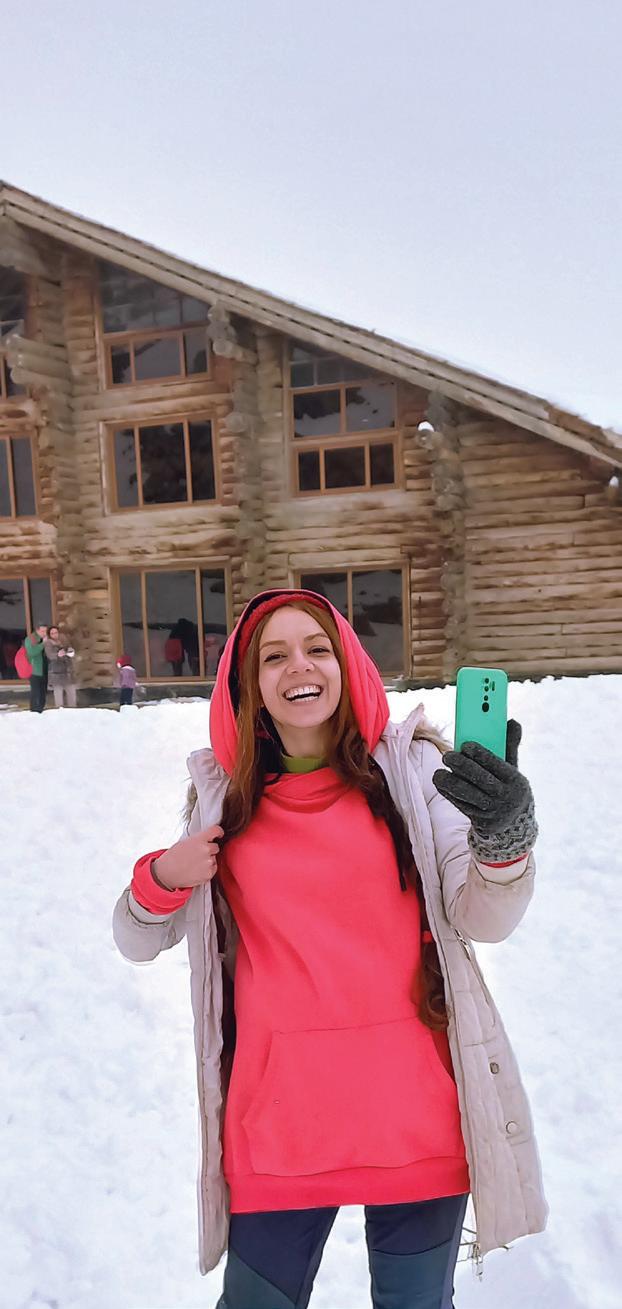




Always fun to spend time with our closest friends at parties.
